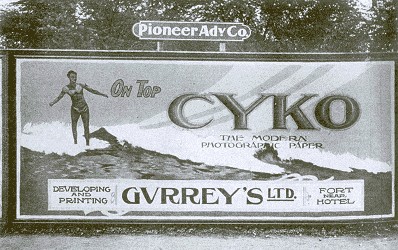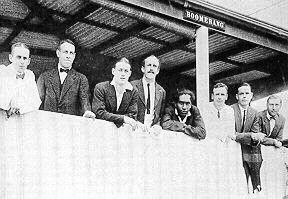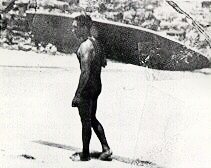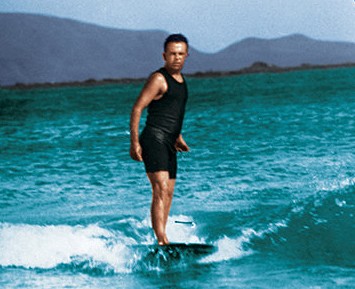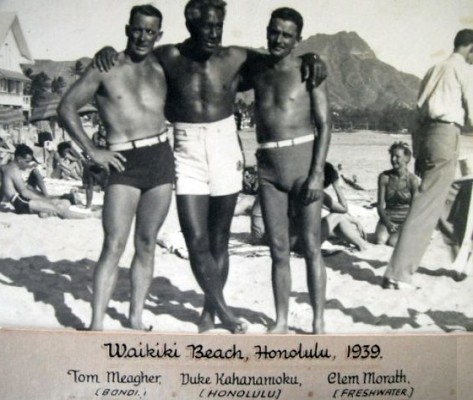surfresearch.com.au
 |
surfresearch.com.au
surfer : duke
kahanamoku
|
Duke
Kahanamoku
(1890 - 1968)
Duke Kahanamoku at Waikiki, 1910.
Selected items
from:
Newspaper
Menu : Surf and Surf-Bathing. Overview.
Following the
formation of the Outrigger Canoe Club in 1908 and the
acquisition of beach front property, its activities dominated
surf riding at Waikiki.
Among its
innovations were the Clark Cup contests, surf-board and
outrigger canoe riding competitions to be held in conjunction
with arrival of Frank C. Clark's cruise ship the Arabic
on two visits to Honolulu on the23rd January and 12th February,
1910
The first Clark
contest was plagued by a small swell and a brisk off-shore wind
and the surf riding competitions postponed.
Preparations for
the second Clark Cup included the construction of an Outrigger
Club float for the Floral Parade and the interest of a film
crew, led by M. Bonvillain of Pathe Freres, Paris
To assist in
shooing film of the contest, K.O. Hall &Son.provided
galvanised iron piping for a platform in the surf zone, which
was erected with considerable difficulty.
Bonvillain shot
some preliminary scenes of junior Outrigger members collecting
their boards from the grass houses and paddling out next to the Moana pier, these
included Lionel Steiner, Harold Hustace, Marston Campbell Jr.
and "Duke."
This is the
earliest report of Duke Kahanamoku in the Hawaiian press.
For images, See
DeLaVega: Surfing
in Hawaii (2011) page 70.
The February
contest was also to include a swimming race between the teams of
the Outrigger Club and the Diamond Head Athletic Club.
The Outrigger
team was Ben Vincent, Alfred Young, Cooper, Harry Steiner, Evans
and "Rusty Brown, captain.
The D. H. A. C.
was represented by D. Center, Glirdler, Duke, L. Cunha, C.
Oss, and Archie Robertson, captain.
Note that the
same report lists David Center and Duke Paua (in the B team, the
"Strawberry crew") as crews of Outrigger canoes in the six
paddle race.
At this time,
club membership appears flexible, with some competitors changing
from club to club or holding multiple memberships.
This regatta was
also plagued by a lack of swell and many events were cancelled.
In August, the
Promotion Committee considered several poster designs for the
upcoming floral parade.
The submitted
works were considered inappropriate, the press in stronger
words, described them as "the three atrocities."
One member
suggested an alternate design based on the image of a surf
rider, "which has been displayed here as an advertisement,"
which
was well received
by the committee.
This was,
presumably, the photograph of Duke Kahanamoku, taken and by A.
R. Gurrey Jr. and used in promoting his photographic studio.
A. R. Gurrey Jr.
published his widely reproduced company logo featuring Duke
Kahanamoku surfing at Waikiki in the Evening Bulletin
of 23rd
November, and two
weeks later the newspaper announced the release of Alexander
Hume Ford's Mid-Pacific Magazine.
On 164 glossy
pages with halftone photographs, it represented a "high
standard in the printer's art" and it was claimed that it
would appear
simultaneously in
London, Boston, New York, San Francisco and Sydney.
1911
By the
end of 1910, Duke Kahanamoku had established a
reputation as one of Waikiki's leading expert surfboard
riders, such that the initial edition of Ford's Mid-Pacific
Magazine featured the first of a two-part
account of surfing, accredited to Duke Paoa, "the
recognized native Hawaiian champion surf rider."
The article was in fact written by Ford
The
introduction to the article noted:
"Duke
Paoa was born on the island of Oahu, within sound of
the surf, and has spent half of his waking hours from
early childhood battling the waves for sport.
He is
now 21 years of age, and is the recognized native
Hawaiian champion surf rider.
Duke
and the members of the Hui Nalu, an organization of
professional surfers at Waikiki, have supplied the
material for this article on the national sport of
Hawaii."
Significantly, the cover featured a photograph by
A.R. Gurrey of Duke
at Waikiki.
The image was also used to advertise Gurrey's
photographic studio in Honolulu and an illustration
based on the photograph was later used to promote
the Mid-Macific Carnival
(1914) and Duke's Australian tour in 1915.
|
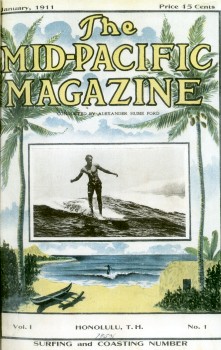 |
The article
was supplemented by several surfboard riding photographs,
probably by the prolific A. R. Gurrey, and given the inclusion
of an article on Skiing in Australia by Percy
Hunter, it is likely that copies of the magazine were
available across the Pacific in Australia.
If a copy came
into the possession of one of the small number of Sydney
surfers, largely centred at Manly Beach, who were beginning to
experiment with Hawaiian type boards, then it would have been
highly prised and eagerly shown around that group.
See Kahanamoku, Duke Paoa: Riding the Surfboard.
The
Mid-Pacific Magazine, Honolulu, Volume 1, Number 1,
January,1911, page 3.
Around the middle
of the year, the Hui Nalu, described as "Waiklki rowers and
swimmers, composed chiefly of Hawaiians," was admitted to
the local branch of the A.A.U.
This new club was
largely an offshoot or a faction of the Outrigger Club, those
previously identified as Outrigger members included Duke Kahanamoku, Vincent
Genoves, Kenneth Winter and Curtis Hustace.
On the 5th
August, the Hui Nalu added twelve new members, making a total of
27.
E. K. Miller, W.
H. King and R. W. Foster were elected as their delegates to the
A.A.U.
The establishment
of the Outrigger Club, with its prime focus on contests in the
surf at Waikiki, allowed the wide program of events that
previously comprised the earlier Waikiki Regattas to be
diversified.
The rowing and
sailing races moved to the more suitable flat water of the
harbour and the swimming events, now under the auspices of the
A.A.U., to the slips between the docks where the length of the
course could be effectively measured.
The program for
the upcoming aquatic meet was released on the 8th August,
initially to be at the Bishop slip.
As the dock was
being used commercially on the day of the event, it was moved to
the Alakea slip.
.
Entrants from the
various clubs included Geo. Freeth and L. Cunha (Healani);
D. Center (Myrtle); and D. P. Kahanamoku and Vincent Genoves
(Hui Nalu).
Freeth's
eligibility was questioned, but after meeting with John Soper,
his application to join the A.A.U. was accepted.
The program did
not include a swimming team from the Outrigger Club, one
reporter suggesting that "the members got cold feet as soon
as the entry list of the Hui Nalus was scanned."
It later
transpired that the club had intended to enter a team, but due
to misadventure, if not "treachery", the correct documents were
not lodged before the official closing time.
Circumstantial
evidence suggested the involvement of the Hui Nalu in the
matter.
While the press
report suggested that disgruntled Outrigger members might
console themselves with that evening's moonlight dance in the
club's lanai, elsewhere on the same page it was noted that the
Hui Nalu club was "at present giving more attention to
swimming than dancing."
Any questionable pre-contest manoeuvres by the
Hui Nalu proved to be unnecessary, and the club emphatically
dominated the swimming races on the 12th
August.
In excellent
conditions, the "water was as calm as a mill pond," Vincent
Genoves won the 440, the 880 yards and one mile and Duke
Kahanamoku won the 50, 100 and 220 yards events.
In addition,
Kahanamoku broke world record times for the 50 and 100 yards.
In a sudden leap
to international fame, the press noted that at the time Duke was
"not well known among the people of Honolulu, but is
remembered by many tourists who have visited Hawaii and taken
a dip in the surf of Waikiki."
As Hawaii's first
event sanctioned by the A.A.U., considerable care was taken to
correctly measure the course before the carnival and the events
were timed by several officials.
Due to some
cynicism as to the validity of these record breaking swims, the
course was re-measured the following day by a surveyor.
It was later
reported that it was, in fact, longer by one and a half feet;
however the records were not officially recognised at the time.
In a regular
column, Honolulu Newsletter published in the Maui
News in August, Oscar Brenton reviewed the failure
of the Outrigger Club to enter a team in the recent swim meet.
He implied that
the club, under the direction of Ford, had alienated a number of
junior members with its rigorous interpretation of amateur
status.
This probably
stemmed from the rejection of a motion to allow the payment of
juniors for providing canoe surfing services, passed at the AGM
on 15th February 1910.
As Duke
Kahanamoku "happens to get his livelihood making surfboards
and occassionally taking tourists canoing at so much a head",
under the rule he was unable to compete "for the Clark cups,
or anything else under the auspices of the Outriggers."
It is likely that
this dispute over the definition of amateur status within the
Outrigger Club significantly contributed to the formation of the
Hui Nalu in mid 1911.
Twelve months
later, the reasons for the defection of some Outrigger members,
notably Duke Kahanamoku, to the Hui Nalu were still considered a
mystery by most in Honolulu.
In July
1912, a reporter for the Honolulu Star-Bulletin
stated "many know, but more do not and the writer of
this is with the latter."
With an element
of regret, the article noted that it "would have been a good
thing from the point of view of the promoter of tourist travel
to the islands" for the international reputations of Duke
and the Outrigger Club to have been combined.
The regatta day
planned for the 12th September was to take place in Honolulu
harbour for a series of races for barges, ship's boats, shore
boats, whaleboats, and modern and old canoes.
There were also
sailing races for boats and canoes.
A barge race was
competed by groups of local government workers as Federal,
Territorial, or County Employees.
Visiting crews
included those of the Resolute, the Patterson,
and the Robert Searle.
Competing clubs
included the Healani Boat Club, the Myrtle Boat Club, the
Puunene Athletic Club, the K. A. C. Seniors, the Outrigger Club,
and the Hui Nalu.
The Hui Nalu
secured the A, Prince Kuhio's canoe, previously
used by the Kona paddlers, to compete in the six and four-paddle
canoe races.
Crew members
included lngworth, Duke Kahanamoku, O'Sullivan, Archie
Robertson, and Vincent Genoves.
They won both
canoe events, placing ahead of the Kamehameha's and the
Outrigger in the six paddle, and beating the K. A. C. Seniors in
the four-paddle race.
The event was
well attended with most support for the Healanis and the
Myrtles, but there were also a significant presence of the "black
and gold" for the Puunene Athletic Club and the "blue"
of the Hui Nalu.
The autumn of
1911 provided large waves at Waikiki.
At the end of
September canoe and board riders rode surf, said by experienced
elders, to be "higher today than at any time in the last nine
years."
Another
substantial swell arrived in November, which persisted for
several days and at one point was large enough to keep the local
fishing fleet at home.
1912
The New Year saw
steps to secure funds to send Duke Kahanamoku to the
mainland to take part in the Olympic trials.
About $230 was
already collected but the trip would require at least $1000, and
"an extra five hundred wouldn't hurt a little bit."
The reporter
noted the need of a manager/coach to avoid "the
wiles and wrinkles of important amateur athletic competitions"
and warned that suggestions by George Freeth that Duke seek
employment in California may prove detrimental to his amateur
status.
The Hui Nalu Club
arranged a dance on Saturday, January 27, at the Young roof
garden
Tickets were $4
each, the proceeds going to the Duke traveling fund.
At the time
swimming was the club's main focus, the press noting the "Hui
Nalu is not a rowing club at present."
In the first week
of February, Frederick Shaffer, a crewman of the visiting
cruiser Colorado, drowned at Waikiki while attempting to
rescue a woman in difficulties.
Shaffer's
companion and the woman were in turn rescued by the Outrigger's
youngest and most recent member, thirteen-year-old Ralph
Williams, Alexander Hume Ford and Duke Kahanamoku.
Williams and
Kahanamoku used their surfboards and Ford had grabbed in the
smallest outrigger canoe available.
Despite an
extensive search by Hui Nalu members and a search party raised
from the Colorado, Shaffer's body was not recovered that
day.
Ford later noted
that the Waikiki boys had regularly performed rescues, " the
Hustace boys with a score of life savings."
During the
following week, Duke Kahanamoku and Vincent Genoves gave
a free swimming exhibition in the Bishop slip before about 200
(?) spectators.
Although neither produced record breaking times,
they gave respectable performances under less than ideal
conditions.
At Waikiki, in
a response to calls for an improvements to beach safety,
The Outrigger Club announced its members would man a patrol
during the tourist season.
Duke Kahanamoku
and Vincent Genoves, accompanied by Lew G. Henderson and "Dude"
Miller departed Honolulu on the 7th February to compete in the
U.S. trials for the 1912 Olympic games.
At the dockside,
members of "the Hui Nalu gave their club yell, a
quintette club sang 'Aloha Oe,' Berger's band struck up 'Auld
Lang Syne.'"
The Hawaiian
Star printed a letter on 12th March from Dr. A. E.
Friesel to his brother, a local athlete, with an account of the
Olympic trials in Chicago.
He noted that
Genoves was severely disadvantaged by the short course tank
which required numerous turns, losing "one and one-half to
two yards on every turn," and failed to qualify.
The tank was less
of a problem for Duke Kahanamoku, in "the finals he won the
fifty yards and the 100 yards by about two feet each" and
he was selected for the U.S.A. team to swim in Stockholm.
Emphasising
Hawaii's status as a U.S. territory, "Duke was brought out
wrapped in the American flag."
Friesel requested
that his brother send him an autographed copy of "one
of those large photos showing him (Duke) standing on
his head on a surf board" to be framed for his office.
On the
mainland, Kahanamoku competed in a series of competitions and,
as of 22nd March, he had won every race he entered, with the
exception of one event at the Pittsburgh Athletic Club where he
retired from the race with cramps,
Described as 21
years old, six foot and 185 pounds, in particular, the press
noted "his style is different from anything ever seen before
in this country."
In interviews
Duke accredited his swimming success to his surf riding
experience at Waikiki.
Despite the years
of strenuous publicity by A.H. Ford to give the Outrigger Club
an international profile, its fame was now rivalled by "the
Hui Nalu ('Ocean Wave' Club) of Hawaii."
In mid May,
Waikiki experienced a large swell and "an unusually large
number of surf board riders were in evidence," while on
shore, a benefit dance was arranged by the Hui Nalu Club
to raise funds for Duke Kahanamoku's trip to the Olympic Games
in Stockholm.
Set for Saturday,
May 25, it was to be held at the Outrigger Club "and tickets
will be sold at 50 cents each."
After a complex
series of events and negotiations, Duke Kahanamoku won the 100
meters swimming finals at Stockholm on the 10th July, 1912.
After setting an Olympic record of 62 2-5
seconds in the heats (ratified after a protest from Germany),
Kahanamoku and the other American qualifiers, failed to appear for
their semi-final due to confusion about the schedule.
After meetings with the Olympic officials and the consent of the
qualified competitors from Australasia (a
combined team from Australia and New Zealand) and
Germany, a repercharge heat was run and two Americans, Duke and Kenneth Hustagh, advanced to the final.
Kahanamoku placed
first with Cecil Healy, representing Australasia, second;
Hustagh was third, followed by Germany's K. Bretting and W.
Ramme.
Australia's
champion, William Longworth, although qualifying for the
final, was too ill to compete.
The complications
in running the event were compounded by difficulties in
communication and it wasn't until six days later that the Honolulu
Star-Bulletin was able to announce Duke's victory
and world record.
Apart from an
outstanding athletic performance, Duke's "style" also made an
impression.
During the games,
James H. Randall, the San Francisco Call's
correspondent in Stockholm observed that he was " the talk
of the town today, not only for what he does, but for the
easy, nonchalant way in which he does it."
Furthermore, the
generous approval by the Australasian and German competitors to
a rescheduling of the semi-finals was highlighted by Dagens
Nyheter, the Olympic Games' special paper.
On 10th July, it
stated "the whole world of sport will ring with applause for
your sporting action in permitting the semi-flnal of the 100
metres to be re-swum."
Apart from Cecil
Healy's extensive career as a competitive swimmer he was also a
leading member of the Manly Surf Club, one of the four clubs
then operating on Manly Beach, Sydney's closest equivalent to
Waikiki.
Healy was, no
doubt, aware of the surfboarding exploits of Tommy Walker of the
neighbouring Seagulls Club and of Duke's surfing reputation..
As such, he had a
bond with Kahanamoku that was rare in Stockholm, and later was
one of the principal figures in issuing an invitation for Duke
to tour of Australia.
In the southern
summer of 1941-1915, he reported on the Kahanamoku tour as a
journalist for The Referee and was directly
involved in the Sydney surfboard riding exhibitions.
Following his
success at Stockholm, the Hawaiian Gazette
reported on the19th July that Duke Kahanamoku would tour Europe
and the United States, before a scheduled return to Hawaii on
the 23rd August.
Meanwhile,
preparations were under-way to honour him, "the gift
probably to take the form of a house and lot, in addition to a
purse."
It printed
selected excerpts from some of Duke's letters back home and
suggested that he would return via "Atlantic City where the
crowds will see him on the surf board."
Duke Kahanamoku
arrived in Atlantic City on 10th August, New York's The
Evening World reporting that "he brought
with him two of the surf riding boards used by the Hawaiians."
The boards were
forwarded from Honolulu directly to the East coast, possibly to
the care of George Macfarlane or the Henderson family, awaiting
his arrival.
The article also
noted that "the City Commisson forbids the use of boards in
the ocean, but has granted him permission to employ the surf
runners two hours a day."
Atlantic City was
not the only civic authority to restrict surfboard use; in March
1912, the NSW Government enacted an ordinance giving local
inspectors power "to order bathers to refrain from
surf shooting, whether with or without a surfboard, where the
practice was likely to endanger or inconvenience other
bathers."
Both cases
indicate that these regulations were in response to the
activities of local surfboard enthusiasts.
Furthermore,
another report of Duke surfing at Atlantic City noted that his
board was "longer than the boards seen here."
Of course, this
was not the first appearance of Hawaiian surfboard riders on the
East coast.
Kahanamoku was
preceded by a group of surfing musicians, "the Hawaiian
quintette", who were booked to perform at Atlantic City
and Ashbury Park, N.J., in July 1910.
At Ashbury Park,
their board riding, "skimming on the crest of a wave for
hundreds of feet", was admired and copied by some locals,
with limited success.
Duke later wrote
to his father that he was "having a great time ... riding
the surf ... thousands of people were on the Million Dollar
Pier."
The New
York Herald of 16th August reported that his
appearances in Atlantic City had immediate impact.
It noted that "amateur
surf
riders here ... have provided themselves with surf boards,"
presumably larger designs than those previously used, and
"a new impetus has been given to surf riding and boys and
men may be seen at any hour of the day when the tide is just
right for the fun trying their skill striding in with the
waves."
His
upcoming itinerary included appearances at Ocean City, New
York, Philadelphia, and San Francisco.
Interviewed at
the end of September, following his return to Sydney from
the 1912 Olympic Games, the manager of the swimming team, Mr. A.
C. W. Hill, raised the prospect of a tour of Australia by "the
brilliant American sprint swimmer Duke Paoa Kahanamoku."
This was only one of the numerous invitations to
Duke following his Olympic success and the Australian tour would
not eventuate until the southern summer of 1914-1915.
Edward Rayment,
the director of the New South Wales Immigration and Tourist
Bureau, visited Hawaii in October 1912 on his way to London to
relieve Percy Hunter, who was to return to Sydney, via Honolulu,
"arriving here during February and remaining for carnival
week."
He was given the
standard tourist treatment including an "afternoon surfing
in canoes and watching the Hawaiian boys and Outrigger members
disporting themselves on the surfboards."
At the Outrigger
Club, Rayment met with Duke Kahanamoku and reiterated Hill's
invitation to visit to Australia.
Later that month
in Sydney, Hill reported to a meeting of the NSW Association
that he had approached several international champions in
Stockholm about their availability to tour Australia, and Duke
Kahanamoku was the most enthusiastic.
The association
resolved to apply to the Australian Swimming Union for power to
extend a formal invitation.
Although the
invitation was for a series of swimming exhibitions, "Merman,"
the natatorial correspondent for the Daily Telegraph,
commented:
"Should
Kahanamoku come to Sydney (he is claimed to be the world
champion surf-shooter in Honolulu), he will surely astonish
local surfers with his evolutions in the breakers."
Preparations were well under way in Honolulu in
December for the Mid-Winter Carnival, the program was to feature
"the Landing of Kamehameha the Great", accompanied by a
large fleet of canoes, at Waikiki.
He was to arrive
on a traditional double war-canoe, requiring Prince
Kalanianaole's canoe and one other to be brought from Kailua,
Hawaii.
At Waikiki, they
were to be "lashed together by a Hawaiian who did the same
for those in the Bishop Museum."
Other events
included surf riding and canoe races, in particular "Duke
Kahanamoku will be a star attraction la the surfing and
swimming performances."
Circa 1912, Aloha
from
Hawaii, a publication produced to promote the developing
tourist industry, included an image (often reproduced) of
Duke and his board on the beach at Waikiki.
 |
"DUKE"KAHANAMOKU
The
Hawaiian Swimmer
World
record holder 100 metres,
Time
1 min. 2 3/5 secs.
DUKE KAHANAMOKU -
The Champion Swimmer of the World.
Island Curio Co.: Aloha from
Honolulu.
The Island Curio Company, Honolulu,
T. H., circa 1912.
Note that
the nose template is standard for the majority of solid
timber boards of this period, and is in marked contrast
to the first board (the Freshwater board) he shaped in
Australia in 1914.
|
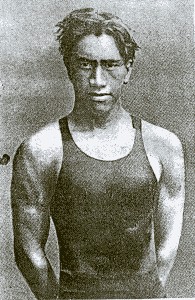
The
Daily Telegraph
30th October, 1912,
page ?
|
Subsequent editions of The Mid-Pacific
Magazine continued to feature articles and
photographs of surfboard and outrigger canoe surfing in Hawaii
(and other Pacific islands) with the December issue of
including a photograph of Duke surfing at Waikiki.
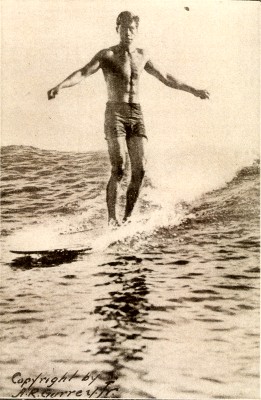 |
Duke Paoa
Kahanamoku,
Hawaii's Champion Swimmer of the World.
Copyright
by
A. R. Gurrey Jr.
The
Mid-Pacific Magazine
Published
by Alexander Hume Ford,
Honolulu,
Territory
of Hawaii,
Volume
4, Number 5,
December,1912,
unpaginated.
Note that
in this image Duke Kahanamoku is riding in "goofy"
stance (that is right foot forward), whereas subsequent
photographs indicate his stance as "natural" (left foot
forward).
Either
the image was flopped from the negative, or more likely,
he reversed his stance for the benefit of the
photographer.
This
photograph, although in natural stance, was later
adapted as the template for an illustrated poster for
the Mid-Pacific Games of 1912.
This
poster was then appropriated by the NSW Amateur Swimming
Association to promote their series of swimming
carnivals in Sydney in 1915.
See below.
|
1913
On 29th January
1913, the Honolulu Star-Bulletin was quick to
pour scorn on a recent story in the opposition Advertiser,
later widely repeated, pro-ported to record "Duke
Kahanamoku's terrific battle with a high-powered, man-eating
eel."
Under the
sub-heading "Quick, Officer, the Padded Cell," the
HS-B reporter interviewed the Duke who confirmed
that there was a confrontation, that is "Duke was nipped by
a small eel when he stuck a finger into a crevice in the
coral."
The original
story was repeated in the Long Beach Press on 29
January, 1913.
The HS-B
also included an interview from the San Francisco Call
of the recent return from Hawaii of "the winner of the
Call's girl wage earner beauty contest," who included
Duke Kahanamoku amongst several gentlemen with whom she was
romantically linked.
At the beginning
of February The Salt Lake Tribune published an
extensive and flamboyant article on Duke Kahanamoku who "Made
the Fastest Swimmers of the World Look Foolish at the
Stockholm Olmypiad, Was Reared in the Surf of His Island Home
and as a Boy Dodged Sharks for Sport."
It was accredited
to Jim Nasium, "Copyright by The Philadelphia. Inquirer Co.",
and was reproduced in several other mainland papers.
Accompanied by
two photographs of Duke, there was also a dramatic surfboard
riding illustration, copied from the cover of John R. Mustek's Hawaii
- Our New Possesion, published in 1897.
Two weeks later
the Honolulu Star-Bulletin reproduced selections
from the Nasium article, identifying it as "a Sunday story
in the Philadelphia Enquirer," and made light of the
stories of shark dodging, the headline reading "Hold on
tight, This story makes Duke Kahanamoku's giant eel look like
a bait worm."
Towards the end
of May, at the request of a visiting team of Australian
cricketers, Duke Kahanamoku gave his first swimming
exhibition since his return to Honolulu.
Held off the
Moana Hotel pier, the event was a casual affair with no starters
or timers, Duke demonstrating his style and skill in company of
a number of locals.
Before starting,
he posed for more than half an hour at the request of tourists
and local photographers.
Afterwards Duke
took some of the visitors from "Kangarooland" into the
surf in one of three large canoes manned by the Hui Nalu, while
other club members gave exhibitions of surf riding.
The cricketers
expressed a desire to see the champion swimmer compete in
Australia, a prospect that was regularly canvassed in their
national press.
In Honolulu on
the 17th June, a morning paper (The Adveriser
?) reported that Duke Kahanamoku was considering an
offer to appear in vaudeville, reputedly at $1000 a week.
The claims were
emphatically rejected by Duke in the afternoon edition of the Honolulu
Star-Bulletin, and he made it clear that there was
no prospect of him turning professional.
He indicated that his prime focus was on the
upcoming swimming events in California, and the day before he had
collected "his special surfing
board" from Waikiki in anticipation of
riding it at Long Beach.
Duke also
expressed an ambition to surf on the beaches of Florida, but
noted few people visit the resorts there "in the baking hot
summer months and the big hotels are virtually closed until
late in the fall."
On the 18th June,
a team of seven Hawaiian swimmers, including Duke Kahanamoku,
left for San Francisco on the Wilhelmina to compete at
the Sutro Baths on the 4th July.
Led by William
T.Rawlins, their arrival was eagerly anticipated and there were
suggestions that further swimming events may be arranged in Los
Angles and surf riding at Long Beach, "where the breakers
usually are heavy and suitable for this kind of sport."
Before competing at the Los
Angeles Athletic Club on the evening of the 11th July, at
the
invitation of Pete Lenz, captain of the Long Beach high school
swimming team, the visiting Hui Nalu squad spent several hours
at Long Beach.
Here, "they
couldn't resist the surf and the Duke gave a thrilling
exhibition of surfboard riding" before a crowd of
"thousands."
After the day's
surfing, Kahanamoku easily won his swimming events that night.
Manager Rawlins
and the majority of the Hui Nalu team; H. W. D. King, Lukelai
Kaupiko, D. Keaweamahi, H. Kahele, C. W. Hustace, Frederick
Wilhelmn and J. B. Lightfoot; returned to Honolulu from
California aboard the Sierra on the 21st July.
Duke Kahanamoku
was to return "in about a week" and Robert Kaawa was
reported to have "yielded to the lure of the footlights and
will go into vaudeville."
Rawlins detailed
Duke Kahanamoku's success in California to the local press.
Apart from his
expected victories, he won the the fifty-yard breast-stroke "
though he has never practiced that style" and in a race
against California's Ludy Langer over three-quarters of a mile,
despite not contesting the distance before, he bested Langer's
record by two and a half minutes.
During the tour,
Curtis Hustace and Duke gave a surfriding exhibition at Venice
where "Hustace came in on the surf -board standing on his
head about twenty times, and twenty thousand people went
wild."
The San
Francisco Call advertised Duke Kahanamoku's final
mainland appearances would be at the Casino Natatorium, Santa
Cruz, on the 26th and 27th July .
The event was
said to include "all the crack swimmers and divers of the
coast, in races, high and fancy diving, surf riding."
The Maui
News of the 9th August reported another invitation
for Duke Kahanamoku to tour Australia with an offer "to pay
the expenses of Duke, his manager and trainer."
It was suggested
that a tour could start with within a month.
Furthermore, the
article commented on the swimming skills of the Solomon
Islanders, "where the great Wickman came from,"
particularly the women, of whom it was said "would
swim circles around anything Honolulu has so far produced."
Crucially,
demonstrating the dispersion of the "crawl" style across the
Pacific, they noted "the famous Duke kick is native, not to
say indiginous (sic), to that section of the world and
the women all use it."
The "great
Wickam" was Alick Wickham, originally from the British
Solomon islands, who was a leading competitor in the Sydney
swimming fraternity and was often accredited with developing the
"Australian Crawl" with the Cavill family in the late 1890s.
In 1949, Wickham
was accredited by C.B. Maxwell with shaping the first surfboard
in Australia around the turn of the century.
She noted that
the board was not a success- it was hand carved from a piece of
driftwood found on Curl Curl beach and sank.
During 1903 he
set a world record for 50 yards and equalled the Australian
record for 100 yards at Farmer's Rushcutter Bay Baths, Sydney.
In 1905 Wickham
led the "Manly Ducks", a team that "performed
exhibitions of fancy diving and swimming," the other
members were A. Rosenthall, L. Murray, H. Baker, and C. Smith.
Harold Baker
later identified Wickham, along with "(Cecil) Healy,
the Martins, Colquhoun-Thompson, Read, F. C. ('Freddie') Williams,
and (Charlie) Bell", as one of "our best
(surf) shooters" (bodysurfers).
Healy and Wickham
were both members of the Manly Surf Club, and Wickham was one of
Cecil Healy's strongest competitors in the lead up to his
selection to the Australasian team for the 1912 Olympic Games.
In 1918, Wickham,
then aged 33 and appearing under the name "Prince Wickyama,"
set a the still-standing world's record by diving from
a height of 205ft 9in. into the Yarra River at Deep Rock Baths,
Melbourne.
The feat was
nearly fatal, and Wickham was hospitalised for several days.
Wickham was not
the first, or the last, Pacific islander to have a significant
influence on Australian swimming and surf-riding.
Body-surfing was
introduced at Sydneys' Manly Beach in the 1890s by Tommy Tana, a
native of the island of Tana in Vanuatu (then the New Hebrides).
His style was
studied and copied by Manly swimmers, notably Eric Moore, Arthur
Lowe and Freddie Williams, who was considered to be the first
local to master the sport.
On the 18th
September, Mr. W. W. Hill, the Australian Swimming Union
secretary, announced that Duke Kahanamoku would visit Australia
to compete in Sydney and Brisbane at the 1913-1914 national
championships
W. T. Rawlins,
president of the Hui Nalu Club, had recently written to Hill
confirming Duke's enthusiasm to tour and noted that on the
recent San Francisco trip "he broke many records, among them
the 100yds record held by your Wickham."
Rawlins wrote
that, following another visit to California in October, "we
will start for Sydney the first week in November."
This tour was
formally cancelled in a cable to the the A.S.U. on the 4th
December.
Mr. W. W. Hill,
in his role as secretary of the New South Wales Rugby Union, was
invited to referee several games in California during October
1913.
These included an
annual match between the University of California and Stanford
University, and matches played by the touring New Zealand "All
Blacks" against the All-American team and California
University.
Returning via
Honolulu in December, he contacted Duke Kahanamoku "in
regard to a visit to Australia," however, Duke was
currently unavailable due to "private business" commitments.
While at Waikiki,
Hill "mastered the art of surf-board riding, and canoeing in
front of the wave."
Hill noted that "the
Hawaiian Athletic Union wants to send a team to Australia next
season."
On the last day
of the year, the Sydney Morning Herald published
an extensive article on Waikiki and Duke Kahanamoku, apparently
based on a recent interview by a visiting Australian, perhaps
W.W. Hill.
It detailed the
Waikiki beach-front, the surfing conditions, and board and canoe
riding, followed by a brief description and biography of Duke
with a list of his five current world records.
While he was
always willing to demonstrate his swimming technique, "when
asked how he 'kicked,' Duke was quite at a loss to explain;
and he finally gave it up, and said he did not know, but just
kept going naturally."
Informed of the
nature of the harbour pools in Sydney, Kahanamoku "was
surprised to hear of the enclosed baths, as, like all
the natives, he has no fear of sharks."
Indicating that
an Australian tour was confirmed for the next December (1914),
the journalist suggested that the climate, the water
temperature, and the 100 metres straight-away course of the
Domain baths would see Duke swim times "even faster in
Sydney than he has done hitherto."
1914
In January, the
Hui Nalu Club, "of which Duke Kahanamoku, world's champion,
is a member," announced plans for a clubhouse at Waikiki.
As a fund-raiser,
the club membership was preparing for two performances of "The
Hui Nalu Follies," to be presented at the Honolulu
Opera House.
The Follies were
held on the 12th and 13th February and the press reported
that it was crowd had "an evening of riotous fun,"
with one of the most popular numbers being a dance by Duke
Kahanamoku partnered by Ned Steel, "dressed like an
up-to-date chorus lady."
At a swimming
carnival at Honolulu at the end of February, Duke won all his
events except for the 50-yard -race, where he was unexpectedly
defeated by Bob Small, of California.
However, Kahanamoku's main rival on the day was
George Cunha of the Healani team, who would later accompany Duke
on the Australian tour.
Around this time, Reg "Snowy" Baker, who
competed across range of sports including swimming and was later a
sports promoter, wrote from Honolulu that he "had the pleasure
of a long yarn with the world's champion swimmer, Duke
Kahanamoku."
He commented on Duke's athleticism, pleasant demeanour, swimming
technique, an enthusiasm for motor-bikes, and his anticipation of
the visit "our great country."
Baker also noted that the carnival there was promoted by
"life-like pictures of Kahanamoku shooting on a surf board;" the
same poster would be reproduced for the Sydney carnivals.

|
Monday
14th December 1914: Arrival in Sydney.
Duke
Kahanamoku , accompanied by 19 year old surfer/swimmer
George Cunha and manager Francis Evans, arrived in Sydney
on RMS Ventura.
Despite a delay due to rough seas outside the Heads, a
large number of officials, press and public were at the
wharf when the steamer docked after a two week voyage from
Honolulu.
The officials included E.S. Marks and W.W. Hill, who as
the secretary of the Australian Swimming Union and had met
with Duke twelve months earlier in Honolulu to advance
preparations for the tour.
Sydney's premier athletic track is named after former Lord
Mayor of Sydney, E.S. Marks who won over forty trophies as
an athlete between 1888 and 1890. He was a founding member
of the North and East Sydney Amateur Swimming clubs, Manly
Surf Club; and the New South Wales Amateur Swimming
Association, and a touring manager for the Australian team
at the 1912 Olympics.
DUKE KAHANAMOKU
The fastest swimmer in the
world, photographed
at
the Sydney Domain Baths two
hours after his arrival in Sydney.
GEORGE CUNHA, SECOND ONLY TO
KAHANAMOKU AS SWIMMER IN HAWAII.
He secured second place in most
of the Pacific Coast Championships, and can do
100yds in 57sec.
He is one of the Honolulu party
now in Sydney.
Photographs: The Referee, 16
December 1914, page 11.
|
 |
After the touring party travelled to their
accommodation at the Oxford Hotel, they inspected facilities at
the Domain Pool and then attended an official reception at the
Hotel Australia.
Cecil Healy, now a journalist for the Referee, Sydney’s
premier sporting publication, missed the ship’s arrival but
attended the evening reception.
At the Stockholm Olympics in 1912, Healy had placed second
to Duke in the 100 metres sprint.
Tuesday
15th December 1914: Tour schedule to include
surf-riding?
The Sydney Morning Herald detailed Duke’s
tour schedule, beginning with a series of swimming
carnivals at The Domain Pool in Sydney on 2nd, 6th and 9th
January and followed by carnivals in several towns in
Queensland.
On returning to Sydney “the Swimming Union will probably
in arrange for a surf display, when the champion will be
seen on the surf-board.
Matters in this direction have not yet been finally
arranged."
The Swimming Union contributed to growing expectations for
a surf display by promoting the swimming events with a
dramatic illustration of Duke surfing at Waikiki.
Copied from the previous year's poster for the Mid-Pacific
Carnival, an illustration base on a 1911 photograph by
A.R. Guery, it also graced the official
program's cover.
Mid-Pacific Carnival
Kampion:
Stoked (1997) page
38, credited to Bishop Museum.
|
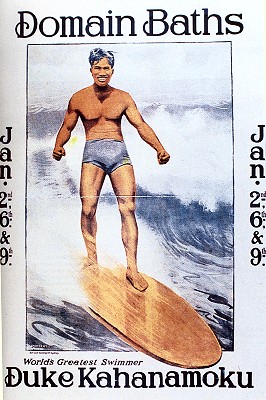
|

|
Wednesday 16th December 1914:
Coogee Carnival, Surfboard Ban? A Board to be Shaped?
Duke Kahanamoku attended the annual Randwick versus Coogee Club
carnival at the Coogee Aquarium Baths.
The competitors included Cecil Healy, A. W. Barry, L. Boardman, T.
Adrian, and W. Longworth and “Miss Fanny Durack gave
an exhibition swim of 200 yards.”
Fanny Durack was another competitor at the Stockholm in 1912, the
first Australian woman to win an Olympic gold medal in a swimming
event.
In the press, the front page of The Referee featured
Cecil Healy’s report of Duke’s arrival and the “magnificent
reception (where he) managed to get a chance to shake hands and
have a chat with him.”
Of course, the outbreak of the war in Europe, with the first
contingent of ANZAC troops already embarked, tended to overshadow
the celebrations.
One of the speakers, H. Y. Braddon, noted that while there ”seemed
to a desire to put off carnivals and similar events, owing to the
war, ... it was a good thing to hold them, as they meant work for
someone.”
Healy questioned Duke on his visit to the Domain Pool (“just fine,
and the water's great") and asked:
" ‘Did you bring your surf board with you?'’, to which he replied:
'Why no, we were told the use of boards was not permitted in
Australia.'
Evidently noticing the look of keen disappointment on my face, he
quickly added 'But I can easily make one here'.
This information, I am sure, both swimmers and surfers will be
delighted to be acquainted with, as holding out prospects of the
acquirement of the knack of manipulating them."
The supposed ban on surfboards in Sydney was reported by American
journalist and enthusiastic (self) promoter, Alexander Hume Ford,
a principal character, along with George Freeth, in Jack London's
celebrated account of surf riding at Waikiki, A Royal Sport,
in 1907.
Following a visit to Australia in the summer of 1907-1908, Ford
published an article in The Red Funnel, an early
tourist magazine, where he claimed that at Manly Beach he “wanted
to try riding the waves on a surf-board, but it was forbidden.”
While surfboard use had been regulated for the safety of
body-surfers on Sydney’s beaches since March 1912, it was not
prohibited.
On returning to Honolulu in 1908, Ford was integral in the
founding of the famous Outrigger Canoe Club at Waikiki on prime of
beach front property, an idea possibly influenced by observing the
beginnings of the first surf life saving clubs while in Sydney.
Thursday 17th December 1914: Competition,
Beaches, and the Needs of a Waikiki Beachboy.
By the end of the week, the arrival of Duke Kahanamoku in Sydney
had been noted by newspapers from Townsville to Perth, including
The Farmer and Settler, The Australian Worker, and The Catholic
Press.
While Duke had few official engagements in the weeks leading up to
his first swimming carnival scheduled for 2nd January, there were
a number of important developments.
Firstly, Francis Evans and NSW Swimming officials were busy
conducting negotiations for Duke‘s appearance at a number of
carnivals in Melbourne.
Whereas the Victorian Association had previously declined
involvement in the tour, with the wide-spread publicity, it was
now seriously reconsidering its position.
Secondly, given the results, it is likely that Duke and George
Cunha did some training to prepare for the swimming competitions.
However, any sessions were probably in the early morning, to avoid
onlookers, and could have been at any one of a number of suitable
local pools.
Also, at some point Duke crossed the harbour, presumably on one of
the ferries of the Manly and Port Jackson Company, and became
acquainted with the beaches of Sydney’s north shore, in particular
Freshwater and the Boomerang camp.
Most importantly, Duke was without a surfboard, a ukulele and some
poi.
Friday 17th - Tuesday 21st December 1914:
Duke’s Freshwater Board
Duke shaped his famous Freshwater board during the first week of
his arrival in Sydney, at some time between 17th and 21st
December.
In many contemporary articles the width and length are often
reported incorrectly, and errors appear in many subsequent
accounts.
For example, Nat Young (1979-2003) records the length as 3.6 m (or
11 ft 10’’). Also note that some have asserted that Duke shaped a
concave section in the bottom, a feature that is not, however,
evident.
The actual dimensions are 8 foot 6.5 inches long, 23 inches wide
and 2.75 inches thick, with a weight of 78 pounds.
All reports indicate the timber as sugar pine (Pinus
lambertiana), a substitute for the significantly lighter
Californian redwood as “a properly seasoned piece of that
particular timber, sufficiently long, could not be procured in
Sydney,” at short notice.
As a result the board was considerably heavier than normal, which
Duke suggested was a disadvantage as his Waikiki board “as a rule
weighs less than 25lb.”
The weight was not the only distinctive feature, the nose template
is unusual and it was not replicated on the boards shaped in
Australia following Duke’s departure.
The template was probably not cut by Duke, Reg Harris (1961)
suggesting that the billet was donated by a timber firm, George
Hudson’s, who “did the rough cutting to Duke’s instructions then
he finished off the finer designing of the bottom of the board.”
Although Hudson's apparently had several timber yards in Sydney,
the principle premises were at Blackwattle Bay, Glebe, and it is
the most likely source of the billet and the initial cutting of
the template by an experienced tradesman.
In the haste to produce a board, the template may not have been
cut exactly to Duke’s instructions.
However, whatever its deficiencies, the board’s status is assured
as Duke generously accepted it in the spirit of aloha and was
happy to use it, apparently, at all his surf riding exhibitions in
Sydney.
Either at Hudson’s or, more likely, after the board was
transported across the harbour, Duke rough-shaped the bottom and
rails with the tools at hand, ideally a small adze and a draw
knife.
He then would have finished it with various grades of sandpaper
and sealed the board with a coat of a natural oil or marine
varnish.
Although by this time a number of surfboards had been built in
Sydney, notably by Les Hinds of North Steyne, this was the first
by a professional shaper.
Given his impeccable credentials, any who witnessed the craftsman
at work were accorded a rare honour.
The board was finished, and even perhaps test ridden at
Freshwater, by the 21st December 1914.
This is simply based on the assumption that whoever placed an
advertisement with the Sydney Morning Herald on
that day did so only with the certain knowledge that the board,
and rider, were ready.
The next morning the Herald announced:
“The New South Wales Swimming Association has arranged for a
display by Duke Paoa Kahanamoku at Freshwater on Wednesday
morning, at 11 o'clock.
The famous swimmer will give an exhibition of breaker shooting and
board shooting.“
Acknowledgement
My sincere thanks Eric Middledorp, the board's custodian at the
Freshwater SLSC, for his dedication and invaluable assistance.
Eric has overseen the recent excellent restoration and enhanced
presentation of Duke’s board, in addition to supervising the
shaping of an active replica.
Saturday 19th December 1914: The Sydney vs.
Melbourne Carnival
Duke, probably accompanied by George Cunha and Francis Evans,
attended his second Australian carnival at the Domain Pool on
Saturday 19th as a spectator.
His attendance at the carnival does not eliminate this day for the
shaping of the Freshwater board, but makes it very unlikely.
The carnival was the annual swimming competition between the
“crack” swimmers from Sydney and Melbourne, with the honours going
to Sydney on this occasion.
On show were Boardman, A. W. Barry, and Tommy Adrian from
Sydney, all potential Duke rivals.
The performance of Ivan Stedman from Melbourne was impressive and
he was seeded into the heats for the first Kahanamoku carnival on
the 2nd January 1915.
This further increased the interest of Victorians in the tour, and
gave Francis Evans and the NSW Association additional leverage in
the negotiations with Melbourne’s swimming officials, now keen to
secure dates for Duke’s appearance in their city.
The word “carnival’ was very apt, swimming races were only the
central feature of a program that regularly included diving
competitions and displays, novelty events, and, occasionally,
musical entertainment.
In the springboard diving at this carnival, Barry was second to
Melbourne’s L. Grieve.
Very popular with the public, the carnivals were a significant
source of income for the amateur Associations, and in this
instance, the cost of the Kahanamoku tour was to be covered by the
gate receipts.
The cost was considerable: steamship from and return, via New
Zealand, to Honolulu, two months first-class hotel accommodation,
transport and all incidentals, for three.
In making the bookings the negotiations could be protracted, the
managers seeking suitable discounts or extras in respect of the
fame of their client, or quickly and amicably arranged by swimming
or surfing enthusiasts or through an “old-boy-network.”
The expenditure incurred by the NSW Swimming Association, or the
income generated by the Kahanamoku tour has never been, even
vaguely, estimated.
In this era, swimming races could be chaotic, with large numbers
of swimmers and often with cases of interference.
Concerned that such problems may detract from the importance of
the upcoming Kahanamoku carnivals, in a letter to the Sydney
Morning Herald, “Swimmer” proposed a novel solution:
“A new scheme might also be tried by roping the course as in foot
running, where each competitor has his own track.”
Sunday 20 December 1914: Not Manly (but
Freshwater?) and the ukulele.
During the first week in Sydney, Duke shaped his board and visited
north of the harbour, in particular, Boomerang, one of several
basic shacks built on the frontal sand dune at Freshwater Beach
shortly after the turn of the century.
It was now owned by Donald McIntyre, a founding member Freshwater
Life Saving Club, who had served as club secretary, and now held
that office for the New South Wales Surf Bathing Association
Given his appearances at carnivals and social events, Duke’s
visits may have been short, but as with the construction of the
board, there was certainly at least one fleeting visit between the
17th and 21st December 1914.
As discussed above, the Sydney Morning Herald announcement
of the 22nd could only have been made once the board was finished
and Duke had tested the waves at Freshwater, with or without the
board, but probably both.
The most likely scenario is one visit to shape, varnish and body
surf, with a return a couple of days later to test-ride the board.
While Freshwater was a surfboard riding beach, it was clearly
second to Manly.
As clearly stated in the official 1910-1911 NSW Surf Bather's
Guide, Manly is “the original home of the surf bather.”
Whereas Freshwater had one surf life saving club, by 1914
Manly had four.
Most had some connections back to the harbour side Manly Swimming
Club, formed in 1905, whose objectives included “proficiency in
life-saving on the Ocean Beach.”
The first club on the beach-front was the the Manly Surf Club,
with its star Olympic swimmer, current journalist and soon-to-be
Duke competitor, Cecil Healy.
This was followed by North Steyne Life Saving Club, with surfboard
shaper, Les Hinds, and C. D. Paterson, serving as president of
both North Steyne and the Surf Bathing Association of New South
Wales.
Claims that Paterson brought, or procured, or was gifted, a
full-size surfboard from Hawaii, sometime between 1908 and 1912,
have never been substantiated.
Several accounts note that the board was unable to be mastered by
the locals; which, in light of other evidence, appears highly
unlikely; and was then retired to the family home as an ironing
board, which appears to be a fable.
Next was the Manly Life Saving Club with Fred Notting, a pioneer
of canoe surfing, which was later to influence, and be eclipsed
by, Harry McLaren’s surf-ski, first tested in the surf at Port
Macquarie in the mid-1920s.
The most recent club was the South Steyne Life Saving Club, with
W. H. Walker as the honourable secretary, a position he had held
in the now defunct Manly Seagull Surf and Life Saving Club, who
had their “membership restricted to residents of Manly.”
The Seagulls had started at the same time as Manly LSC, both
recruiting disaffected members from Manly Surf, which refused to
register with the newly formed state body.
Besides W. H., the Walkers (some of the connections are unclear)
were a prominent force in the surf along Manly Beach.
As well as George and Monty Walker, of Manly, there was Tommy
Walker of the Seagulls and Yamba.
Tommy did travel to Waikiki, did buy a surfboard there, did bring
it back to Australia, and by 1912 was able to ride it upright like
the Hawaiians, both on his feet and on his head.
In early 1912, Tommy Walker, on his “Hawaiian surfboard” and Fred
Notting, “in his frail canoe, The Big Risk" gave demonstrations at
carnivals at Freshwater and Manly.
They repeated these the following summer, however, this time Fred
was “accompanied his dog, Stinker.” In the early 1920's, Russell
Henry 'Busty' Walker, following Fred Notting, was invaluable as a
judge at the buoys at Manly Surf Carnivals and around the same
time, W, H. Walker’s son, Ainslie "Sprint" Walker, introduced
board riding to Torquay.
Tommy Walker was an inspiration to other locals and in early 1913,
while enacting another ineffective ban, one Manly Councillor
claimed to have “seen no fewer than 10 surfboards in the thick of
bathers,” but “Dumper, an old hand on the board,” later suggested
this was a considerable exaggeration.
The next summer records the first surfboard injury in Australia,
not surprisingly at Tommy Walker’s, second home, Yamba, and later
the same year Harald Baker crowned “young Walker the surf
board king."
With board riding “a practice at Manly for some years past ...
Young McCracken is (Tommy Walker’s) closest rival,” followed by G.
H. Wyld of Manly and “Champion Sprinter Albert Barry.” In the new
year both Wyld and Barry were to compete against Duke in the pool.
Baker, an outstanding swimmer and a captain of the Maroubra Surf
Club, considered “Miss (Isma) Amor is the best lady exponent so
far,” a view supported by other accounts.
As well as Manly and Freshwater, by the winter of 1914, surfboards
were known to be in use at Coogee, Maroubra and Cronulla.
With the status of Manly as Surfboard-City, why did Duke go
to Freshwater?
Donald McIntyre accommodated Duke in a shack at Freshwater, while
he could have, more comfortably, done so at his family home, of
the same name, in Manly.
And if not the McIntyre residence, there were undoubtedly several
other families in the village who would have warmly welcomed their
visitor.
In the lead-up to the tour, Manly’s Cecil Healy was an
enthusiastic champion of Duke, devoting considerable column space
to his achievements in the pool and strongly encouraged the
staging of surf-riding exhibitions.
At the end of November, three weeks before Duke’s arrival, Healy
wrote that the North Steyne Surf Club had initiated negotiations
with the NSW Swimming Association for Duke to “give a display of
surf-board shooting at its carnival, to take place about the
middle of December.”
A precedent was set, and a brisk exchange of opinions and options
between managers and officials would play out over the following
weeks.
By the 21st Duke had his surfboard and by the 19th he had a
ukulele, just in time to perform several numbers, with Cunha and
Evans, at the dinner party following the Sydney-Melbourne
Carnival.
“The three visitors were delighted when the instrument was
produced ... procured in Sydney through the courtesy of George
Walker, Manly.”
This was not the first exchange of important gifts between the
Walkers and Duke Kahanamoku.
In notes prepared for, but not used by, C. Bede Maxwell in her Australians
Against the Sea (1949), the talented Palm Beach board rider
and the president of the Surf Life Saving Association of Australia
from 1933 to 1974, Adrian Curlewis, recalled that Duke’s
Freshwater board was handed over to George and Monty Walker of
Manly.
Later, “because of the fine work Claude West had done in
popularising surfboard riding, (they) eventually gave it to Claude
West, and he still has it, a prized possession.”
At the end of the1930s, Harry McLaren’s surf ski made its first
excursion outside Australia when “the Walker Brothers sent a surf
ski to Duke Kahanamoku at Honolulu and members of the Australian
Pacific Games Team which visited Honolulu in 1939 say Duke was
often seen paddling around on his ‘ski from Australia’.”
Brief footage from around this time of Duke riding the ski at
Waikiki, while standing with two women passengers and a beach-boy
steering at the tail, is remarkable.
Monday 21st December 1914: A tour
of the South Coast, meanwhile, Freshwater contacts the SMH.
The highlight of the day for the Kahanamoku party was intended to
be a motor-tour of the South Coast.
However, while they were in transit, a brief conversation with Sydney
Morning Herald by someone from the Freshwater club
would prove to have significant ramifications.
This would suggest that the board was already completed at least
the day before, Sunday 20th.
The touring party consisted of Duke, George Cunha and Francis
Evans with representatives of the Association and friends
including swimmers Freddie Williams, Jack Longworth, Redmond
Barry, and Miss Fanny Durack.
The “South Coast” was probably the road from Stanwell Park,
possibly going as far as Bulli and the cars were provided “by
Messrs. Phiffer, M’Lachlan, Sam Smith, and F. Stroud.”
The day served as trial-run for Mr. Stroud of the Cronulla Club,
some members of which were known to have experimented with
surfboards.
Stroud was one of the drivers who transported the Hawaiian
swimmers from Sutherland station to Audley on 7th February, before
they proceeded to Cronulla by ferry for their last appearance in
the Australian surf.
While Manly had a long history as a tourist attraction, ideally by
the ferry from Circular Quay, the northern beaches were slower to
develop. Just far enough away from Manly to avoid the scrutiny of
the officials who were charged with enforcing bathing
restrictions, Freshwater’s other attractions were cheap
real-estate, protection from the prevalent summer Nor-Easter, and
an escape from the “suburbanites.” (For east coast surfers, this
often indicates residents of any suburb located to the west of
their own; invert this for west coast surfers).
Fred Notting, in an early example of “surf rage,” recalled the
days of his youth:
"We used to abuse the living daylights out of those we brought in
(rescued).
Put them off coming back to 'Freshie' pretty often. Suited us!"
Freshwater demonstrated its support for surfboard riding as early
as 1911, the club secretary, W. R. Waddington, wrote to the local
council to protest against the imposition of a ban and applied
“for authority to regulate the use of surf boards on Freshwater
Beach.”
Although a ban “would deprive many of the members and visitors of
the full enjoyment of the exhilarating surf,” the council
“unanimously agreed not to permit the use of the boards at
Freshwater.”
As in many cases of prohibition, the ban was impossible to
rigorously enforce, and complaints about surfboards to the press
and the passing of council motions continued.
Boomerang, was owned by Donald McIntyre, a founding member
Freshwater Life Saving Club, who had served as club secretary, and
now held that office for the New South Wales Surf Bathing
Association.
Recall that the current president of that body was C. D. Paterson,
who was also president of North Steyne.
For Duke, staying at Boomerang provided relatively secluded access
to the sea to become familiar with Australian conditions.
It was probably also a respite from the consistent attention of
fans and the press.
The rudimentary facilities of the shack may have replicated his
early days at Waikiki, but, this may, or may not, have been an
attraction.
Over the past two years Duke had visited the largest cities of
North America and Europe, and, in comparison, the facilities on
the tour of Australia were probably fairly average.
New Zealand was still to come.
As North Steyne had already made an approach about hosting a
surfboard riding exhibition by Duke well before his arrival, the
prospect such an event was likely to be raised with some of the
other Sydney clubs.
Of course any appearance would have to be with the consent of the
Swimming Association and at a suitable time in the schedule.
Don McIntye, distinctive in a white suit, is prominent in many of
the photographs, indicative of his central role in organising the
exhibitions and over-seeing Duke’s needs at Freshwater. These
duties may have included contacting the Sydney Morning
Herald on this day with the details of an exhibition
by Duke to be held in two days time.
However, regardless of who made the call, the situation was only
made possible courtesy of W. H. Hill, undoubtedly the prime
conduit in securing Duke’s appearance at Freshwater.
As the secretary of the Australian Swimming Association, Hill was
privy to all the plans and deals in organising the tour, beginning
twelve months earlier when he meet with Duke, and negotiated and
his management, in Honolulu.
Secondly, he was a founding member of the Freshwater club, serving
as the “starter” at the inaugural carnival in 1909, and familiar
with the aims and available resources of the club. Aware that an
exhibition on one of Sydney’s beaches was a realistic possibility,
Hill was keen to secure the event for his club, and the prospect
of shading their rivals over the hill, North Steyne, was a further
encouragement.
If any more incentive were necessary, the fact that North Steyne
was the club of C. D. Paterson, Hill’s president at the NSW Surf
Bathers Association, possibly added a personal element. W. W. Hill
had recognised that the club which first presented Duke in
Australia would achieve incontestable prominence in surfboard
riding, a view that has proved to be remarkably accurate.
Within the first days of Duke being in the country, Freshwater a
club had probably already made an arrangement directly with
Francis Evans, possibly at his suggestion, in the belief that this
would be independent of any contract with the Swimming
Association.
However, as it was likely that the date of the surfing exhibition
was initially unspecified; as it would, at the least, depend on
procuring a suitable board; the speed in which the first
exhibition was arranged may have surprised Hill, along with
many others.
The Hawaiian managers were familiar with such difficulties, and
the income generated by Duke’s surfing, initially surfboard
shaping but also exhibitions, was a consistent threat to his
amateur status as an Olympic swimmer in the eyes of US
authorities.
In 1922, his endorsement for Velspar marine varnish raised the
amateur issue once more some for American administrators.
As noted above, any appearance by Duke would require the consent
of the NSW Swimming Association and at a suitable time in the
schedule, and the will of the board would prevail, although they
also recognised the need to negotiate a suitable compromise.
Tuesday 22nd December: Surfboard Exhibitions Announced.
This morning the Sydney Morning Herald announced :
“The New South Wales Swimming Association has arranged for a
display by Duke Paoa Kahanamoku at Freshwater on Wednesday
morning, at 11 o'clock.
The famous swimmer will give an exhibition of breaker shooting and
board shooting."
As discussed above, this information could only have been passed
to the Herald for publication on the previous day (Monday, 21st)
and once Duke had shaped his board and assessed the Freshwater
surf as suitable.
The notice undoubtedly originated from Don McIntyre, secretary of
the Freshwater L.S.C., however a proxy may have made the contact
with the Herald.
At the Freshwater club on Tuesday morning, in eager anticipation,
the members would have been busy preparing for the next day’s
events, with realistic expectations of a considerable crowd.
However, when the officials of the NSW Swimming Association became
aware of the event, there was consternation. In their view, the
announcement clearly contravened their contract with Duke,
specifying his first public appearance in Sydney as 2nd January.
While the managers and officials were under considerable pressure,
the swimmers were probably largely shielded from most of the
contractual intricacies, and Duke could have been relatively
relaxed.
In respect of the upcoming exhibition, by now he had several years
of experience in appearing before the public, both at swimming and
board riding events.
On the surfboard he had competed and given exhibitions many times
in Hawaii and had demonstrated his skills on both coasts of the
United States.
While the waves of Freshwater were definitely different from those
of Waikiki, Duke had undoubtedly encountered similar conditions,
perhaps worse, at some of the beaches of North America.
Of all the officials, it is to be expected that the pressure on W.
H. Hill was extreme.
While he was likely the initial contact between Duke’s management
and the Freshwater club, as secretary of the Swimming Association
he was now required to protect, and enforce if necessary, the
terms covering their considerable investment.
The accusations, condemnations, and negotiations continued all
day, and only on the following morning was the difficulty finally
resolved. To his credit, Hill probably had a major role in
negotiating the alternative proposal that was accepted, if
somewhat reluctantly, by all the interested parties.
That is, except a hugely disappointed public.
It appears that Duke Kahanamoku did not meet with Australia’s best
board rider, Tommy Walker, in the summer of 1914-1915, as he had
probably steamed north to work at Yamba before Duke arrived in the
country.
In a remarkable case of coincidence, on the very day the Duke
notice was published in the Sydney Morning Herald , the Clarence
and Richmond Examiner reported that the program for the Yamba Surf
Life-saving Brigade Carnival, scheduled for New Year's Day, was to
include:
“An exhibition of shooting the breakers with the aid of a board is
to be given by Mr. T. Walker, who has had considerable experience
on other well-known beaches.”
Fortunately for the Yamba club, the announcement of Tommy’s Yamba
exhibition did not embroil it in a series of complex machinations
between managers and officials, such as was now taking place in
Sydney.
Wednesday 23nd December: The Exhibition that
Wasn’t.
Having read or heard of the Herald’s announcement published
yesterday, the vast majority of the spectators making their way to
Freshwater on this morning were completely unaware of the general
consternation behind the scenes.
Even most of the locals and club members were probably only aware
of rumours of certain difficulties.
Although only two sentences, the announcement built on a swell of
anticipation as Duke’s surfing skills had been highlighted in many
of the articles appearing in the lead-up to the tour. Furthermore,
it is possible that some copies of posters, prepared by the
Swimming Association to promote Duke’s appearance at the Domain
Pool in January, were already in limited circulation.
These featured an impressive illustration of Duke riding his
surfboard at Waikiki. It is reasonable to assume that these were
highly collectable, and they may have often disappeared
mysteriously when posted in a public place.
The design was lifted directly from the poster for the Mid-Pacific
Carnival at Honolulu in early 1914.
However, for the Domain poster the illustration had been
hand-coloured.
It was based on a photograph by A. R. Gurrey Jr., taken in 1910
and, thereafter, it was extensively reprinted or referenced. Its
first commercial appearance was on a large bill board advertising
“CYKO, The Modern Photographic Paper,” available from Gurrey's
Developing and Printing, Honolulu.
In 1911, the photograph was on the front cover of the first
edition of Alexander Hume Ford’s The Mid-Pacific Magazine.
That is, the Alexander Hume Ford who surfed with Jack London
in1906, was told surfboard riding was banned in Sydney in 1907,
and then returned to Waikiki to help found the Outrigger Canoe
Club in 1908.
Sydney’s response of to the announcement was swift and one
journalist suggested that the crowd that morning at Freshwater
numbered almost 3000.
(To this day, well-meaning and enthusiastic journalists greatly
over-estimate the number of spectators at a surfboard riding
events)
The crowd was to be severely disappointed and by 11 o’clock, it
was clear that the there would be no surfboard riding to be seen
today.
By the evening, the news of the cancelled exhibition was all over
the Sydney, as reported by W. F. Corbett in the later editions of
The Sun. Corbett noted that the Swimming Association confirmed
that Duke's" first appearance in public will take place at the
Domain” and it was “controlling his visit to this country.”
Furthermore, “the announcement of any other arrangement with
Kahanamoku as the central figure has not that body's authority."
A week later in The Referee, Cecil Healy suggested
that, rather than an uncomfortable conflict between the Swimming
Association and Freshwater, the postponement of the event was the
result of a simple miscommunication.
Healy seemed to imply that the event had been organised jointly by
the Association and Freshwater, and their intention was to present
a strictly “a private exhibition” for the press.
The announcement forwarded to the Herald, and presumably to the
other newspapers, was meant to encourage it to send a reporter,
and not intended for publication.
This is highly plausible, the only difficulty being that as it
appeared several days after the crisis had passed.
As such, Healy had the benefit of hind-sight and this explanation
may have served to dispel any residual ill-feelings, at least
between the officials and managers.
Whatever the facts, this was of little consolation for an
inconvenienced and disappointed public.
The use of the word “postponement” by Healy was critical.
Corbett’s article had strongly implied that the situation was
emphatically resolved, and any appearance by Duke before the
swimming carnivals was virtually impossible.
The negotiations probably continued well into the morning.
As the announcement had appeared in Tuesday’s Herald, the option
of submitting a retraction that afternoon, to be published on the
Wednesday morning, does not appear to have been considered.
The compromise position was to first, cancel today’s event.
Secondly, without any public announcement, another exhibition was
scheduled for the following day.
And finally, a public exhibition at Freshwater was to be held on
the morning of 10th January, with possibly a visit to Manly in the
afternoon.
As this day was immediately after the last carnival at the Domain,
the prominence of the NSW Swimming Association was confirmed.
The negotiations, claims and counter-claims over the surf riding
exhibitions strongly imply that at some stage that there was an
exchange of money.
The tendency of US administrators to see Duke’s surfing income as
impinging on his amateur status as a swimmer has been noted above.
On this day, the Sydney Morning Herald reported
that:
“The Australian Swimming Union received a cable message from the
secretary-treasurer of the Amateur Athletic Union of United
States, through the Hawaiian Athletic Association, vouching for
the amateur standing of George Cunha and the Duke Kahamamoku, and
granting them permission to compete in Australia.
A similar statement asked for by the United States Athletic Union
regarding the understanding of the Australian swimmers, was
cabled.”
To look slightly ahead- over the following days the surf riding
performance at Freshwater was lauded by those reporters who were
lucky enough to attend.
For any members of the public who had followed Duke’s story in the
papers and had travelled to Freshwater on the Wednesday to see the
exhibition, the knowledge that they had missed out the next day
probably induced a wide range of responses and opinions.
Thursday 24th December: Duke’s First
Exhibition.
Some of Sydney’s surfing enthusiasts became aware that they had
missed out on Thursday afternoon when The Sun
published W. F. Corbett’s account of the morning’s events under
the title: “Wonderful Surf Riding - Kahanamoku on the Board – A
Thrilling Spectacle.”
Corbett, who the previous day had had broke the story of the
aborted exhibition, noted that the small number of spectators with
“only a few pressmen, some members of the New South Wales Amateur
Swimming Association, and the casual Freshwater bathers present.”
Had it been held on the previous day, “the roars of applause (of)
thousands of Australians might have greeted Kahanamoku 's display
at Freshwater.
Clearly based on interviews, probably before and after, as well as
observing the surf riding, Corbett notes the antiquity of
surfboards and surf-riding, although throughout the article the
term surf board is not used.
It is variously referred to as a board, a surf riding board, a
canoe, and a raft.
Boards were to be found in “the Honolulu (Bishop) Museum -
narrow ones, 20ft. in length, and hoary with age” having
been ”used in his (Duke’s) native islands from time immemorial.”
Such information should have readily come to hand; surfing’s
ancient history covered in Riding the Surfboard, attributed to
Duke Kahanamoku and published over the first two editions of A. H.
Ford’s Mid-Pacific Magazine in 1911.
The shape of the board was “almost that of a coffin lid, with one
end cut to very nearly a point,” and Corbett gave a good
approximation of the dimensions, “about eight or nine feet long,
2ft. across.”
He was the first to note that sugar pine was substituted for
redwood, preferred for its light weight, because a suitably sized
blank “could not be procured in Sydney.”
Whereas, at Waikiki boards were about 68lb., “the board used by
Kahanamoku weighed 78lb.”
The difference in weight was later noted by others, however
the discrepancy between the two timbers could vary considerably,
with one reporter suggesting Hawaiian boards could be “less than
25lb,” certainly an exaggeration.
As some sort of guide, one 10-foot board shaped of Californian
redwood board is said by its Newcastle owner to weight about 80
pounds.
Duke’s board, at 8.5 feet and, a close 78 pounds, suggests the
sugar pine is approximately 20% heavier.
Although surfboards in Hawaii were occasionally built of sugar
pine, in this case, its use was clearly a function of the haste in
which the board was constructed, and, undoubtedly, the success of
the exhibitions initiated an intensive search to obtain supplies
of suitably sized redwood blanks or billets.
Upon launching, Duke paddled the board with amazing speed, easily
out-pacing swimmers W. W. Hill and Harry Hay, who attempted to
accompany him.
Up to this point, W. W. Hill, secretary of the Swimming
Association and Freshwater stalwart, had played an integral role
in the tour, and it was unlikely that he would stop now. (For a
digression on Harry Hay, and some bloke called Kenneth Slessor,
see below.)
All the reports, and photographs of the day, indicate the surf was
a least four to five foot (Bascom, 1964), perhaps larger,
choppy, and certainly with no hint of an off-shore breeze.
The waves tended to break quickly without form, and not with “long
roll (of) 300 and 400 yards” of Waikiki that “Kahanamoku would
have preferred.”
Duke seems to have paddled , with little difficulty, to the
outside break, “fully a quarter of a mile,” and proceeded to ride
green faces; in itself something that only the most skilled
Australians may have attempted, or even contemplated, on
waves of this size.
In this era it is probable that most local riders, particularly in
waves of this size and breaking a considerable distance from the
beach, would launch on the already broken wave and mostly ride the
white-water (technically, a wave of translation) shoreward.
Today, riding the white-water is often disparaged today as a
rudimentary skill, however, over millennia this part of the
surf-zone has served as a relatively safe arena for the
development surf skills.
Also note, that in some instances, the white-water can “reform”
and present the rider with a new, though smaller, clean wave face.
Paddling for “the breaker he wanted, (Duke) rose to one knee
first, then became gradually erect, and reached the crest to shoot
foreword with astonishing speed and marvellous balance considering
the troubled condition of the motive power.”
Several times he rode facing backwards and while balanced on his
head, and, what might have been described as a “360" - while
riding prone, Duke the rotated the board, from nose-to-tail-to
nose, underneath him (?).
Corbett noted that “Kahanamoku does not profess to be a champion
when in his island home, but "he is, he says as good as the very
best there.”
At Waikiki, Duke had plenty of competition.
When Duke and Curtis Hustace appeared at an exhibition at
California’s Venice Beach in 1912, "Hustace came in on the surf
-board standing on his head about twenty times, and twenty
thousand people went wild."
This was, surely, another example of a journalist over-estimating
the number of spectators at a surfboard riding event.
A digression, or an aside, or a footnote, or
simply thinking too much: Harry
Hay and Kenneth Slessor, 1931.
According to Corbett, Harry Hay was an accomplished swimmer, able
to “throw a100 yards behind in little more than a minute.”
In 1920 he represented Australia at the Olympic Games in Antwerp
and later became a recognised swimming coach.
Hay’s Swimming and Surfing, published in Sydney by
Jantzen, the swimsuit company, in1931 is probably the first book
with specific instructions for surfboard riding, unless one wants
to count Jack London’s flamboyant account, A Royal Sport.
Initially a magazine article in 1906, A Royal Sport was
re-published in book form as a chapter of Voyage of the Snark
in 1911.
The other candidate for “the first book with specific instructions
for surfboard riding” was also published in Sydney and around the
same time, Surf- All About It.
The book has no indication of the date of publication; furthermore
it lacks any acknowledgement of the author, editor, publisher, or
printer. However, the copy held by the Mitchell Library, Sydney,
has a pencil annotation on page seven which appears to attribute
copyright or contribution to "Slessor 26.2.31."
This was Kenneth Slessor, a noted Australian poet of the period,
and a copy is included in Slessor’s papers held by the National
Library of Australia.
It is likely Slessor had the book published through the printery
of Smith's Weekly, where he worked, with illustrator
Virgil Reilly, from 1927 until 1940.
Reilly is the artist likely to be responsible for the book’s
numerous black and white illustrations.
The elegy Five Bells, prompted by the drowning of Joe
Lynch in Sydney Harbour in 1927, is generally regarded as
Slessor’s finest poem.
It is perhaps not surprising that, compared with Slessor, the
surf-riding instructions Harry Hay are far more basic, concise and
effective.
Friday 25th December: The Day after Duke’s First
Exhibition.
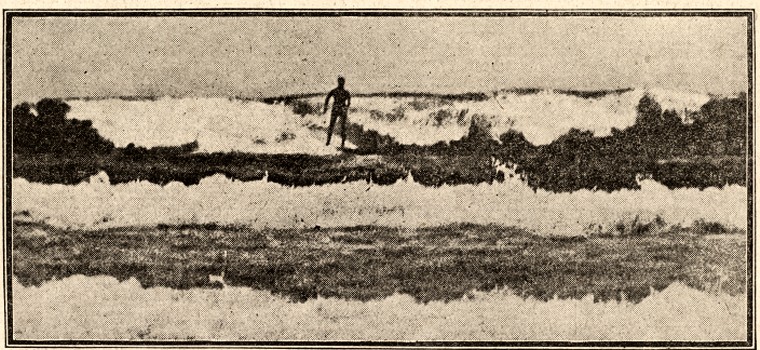
DUKE
KAHANAMOKU, THE HAWAIIAN SWIMMER,
RIDING THE BREAKERS ON A BOARD AT
FRESHWATER YESTERDAY.
The Daily Telegraph
Friday 25th December 1914, page 7.
If any of Sydney’s surfing enthusiasts were unaware W. F.
Corbett’s article in Thursday’s Sun, by Christmas morning Duke’s
appearance at Freshwater was widely known with articles in both
morning papers.
And by now, along the northern beaches, the message went out from
the Freshwater locals- “you really missed it, you should
have been here yesterday.”
The Sydney Morning Herald carried an unaccredited
account on page 4 and The Daily Telegraph had an
impressive photograph and a brief and concise report on page 7,
also unaccredited.
Note that the standard practise at this time was to print the bulk
of the advertising over the front pages, with the news starting
inside.
As such, these articles were “front page news.”
The piece in the Herald could have been, to be
kind, “summarized” from Corbett’s piece in The Sun
of the day before
As the Herald had, perhaps inadvertently, made the first
exhibition public, they may not have been effectively notified of
its postponement to the following day.
On the other hand, the article did indicate that a public
exhibition was already scheduled (for the 10th January):
“If the condition of the water is favourable when Kahanamoku makes
his public appearance in surfboard riding in Sydney it is sure to
be keenly appreciated.”
The Telegraph’s journalist reported only one
head-stand, but added that:
“Several enthusiastic surfers amoungst the spectators endeavored
to emulate the feats of the Hawaiian, but mostly the board either
shot from under them or turned over.”
Despite the brevity of the Telegraph article, under
the header Acrobatics in the Surf, the dramatic photograph of Duke
cutting hard-left on his board was worth a thousand words.
Only the newsprint copy of the photograph has ever been
reproduced, the original negative and/or print appears to have
been lost.
On the weekend, further photographs were published in the Sunday
Times, one carrying the board on his right shoulder
and another riding in the shore break, where at the end of a ride
Duke poses for the camera with his hands-on-hips.
Both have been reprinted widely, with the latter occasionally
accredited as Cronulla.
The Sunday Times began “there is one man only in
Australia at the present time who can get aboard a breaker,” which
would have been news to Tommy Walker and his mates at Manly and
Yamba.
Indicating that the advertising poster, based on Gurrey’s
photograph of 1910, was in already in wide circulation across
Sydney, the reporter suggested that “the man on the poster is the
Duke all right, but the picture errs on the side of modesty.
It should have shown him balancing himself on his head on the
board.”
The article notes the dimensions of the board, reasonably accurate
at “8ft. 6in. long, 2ft. wide, and three inches (thick),” the
“coffin lid” shape, and that it was “made locally from sugar
pine.”
While “Kahanamouku's (Waikiki) board is made of redwood, about
10lb. lighter, he is immensely pleased with the local production.”
The board is said to be sealed with “shellac, (the) surface is as
slippery as a dancing floor,” but before surfing, Duke “rubbed
sand into its surface liberally that it will be equal to his
own.”
The conditions were inferior to those of Waikiki, where Duke was
famed for taking “a boy out to sea, and mounting his board allows
the youngster to climb on to his back.”
The extreme difficulty of this was obvious and “of course, it
would be a rare occasion when he would be able to perform this
feat round the Australian coast.”
The feat would be demonstrated at the Dee Why exhibition in
February.
There were several advantages in surfboard riding and “once one
has become expert ... he forsakes body surfing for ever.”
The article claimed that “it is faster in every respect, is not
nearly so tiresome, and as for exhilaration, well there is the
same difference as between cycling and motoring.”
Noting that “ there is a good deal of danger in the sport, the
solution suggested by the journalist has proved to be an
practical and effective prophesy:
“ (if) various portions of the beaches round Sydney are set apart
for the express purpose of surf- board riding, there is no reason
why it should not become popular locally. “
The exhibition saw the demand for surfboards sky-rocket.
Whereas serious enthusiasts were franticly searching Sydney’s
timber yards for slabs of redwood, the article quoted one of the
local swimming enthusiasts, who referenced the traditional canoes
of the Australian Aborigines: "I'm giving up (body) surfing; I'm
going to duck into the bush right now to search for a piece of
bark;" Undoubtedly, “he wasn't the only one in the vicinity filled
with the same ambitions.”
On Christmas morning, the Hawaiian party, Freshwater L.S.C. and
the Swimming Association should have all been delighted with the
impressive press coverage.
Duke now had time to relax from the frantic activity of his first
week in Sydney, his next appearance was an exhibition for
school children on the 30th, with the first Domain Carnival two
days later.
Although limited by a reoccurrence of “swimmers ear,” he probably
completed a number of training sessions and there may have been
some time for recreational surf-riding.
For Duke, these may have equated to the same thing. When touring
California in 1912, it is recorded that Duke gave an exhibition at
the beach during the day, and then competed successfully in the
pool that evening.
Saturday 26th December: Boxing Day.
As noted earlier, Duke’s next appearance was an exhibition for
school children in six days time, followed by the first Domain
Carnival on the 2nd January.
This week was likely to be spent relaxing, some training, and a
round of social occasions with officials, press and fans.
There was also possibly time for some surfing, and in far better
conditions than those dictated by the late-morning exhibitions.
Given the demand, the search for redwood billets continued and by
the end of the week Duke may have had time to shape a surfboard,
or two.
The importance of the surfboards cannot be underestimated.
With respect to the question of Duke’s amateur status, it was easy
for Francis Evans to arrange, and disguise, the sale of boards,
probably via a proxy, to the direct benefit of Duke.
The significance of these boards to Australian shapers will be
discussed later.
On Boxing Day, the Yamba Surf Life Saving Brigade advertised their
fourth annual carnival, with the seventh event on the program:
“Shooting the Breakers, with and without surf boards, by members
of Yamba Surf Life Saving Brigade.”
One member of the Yamba Surf Life Saving Brigade, with a
surfboard, was definitely the Manly’s Tommy Walker, with a slight
implication that there may have been, at least, one other.
“Shooting the Breakers” was on the program the first inter-club
surf carnival at Manly in 1908, but this strictly referred to,
what is now termed, body-surfing.
Introduced at Manly in the 1890s by Tommy Tana, from the Pacific
island of Tana, it was later popularised by Fred Williams, who was
invited to give demonstrations at beaches north and south of the
harbour. Williams appeared, along with Tommy Walker, at the North
Styene Carnival in 1911, in a body-surfing demonstration, or what
may have been a competition.
Other shooters included C.D. Bell, E. Notting and R. Bowden, all
later to be known board riders.
Following the board riding exhibitions of Duke Kahanamoku, these
events gradually faded out from the surf carnival programs.
The carnival also included a surf-boat race.
This is also significant, and I intend to discuss this tomorrow.
Sunday 27th – Tuesday 29th December: Kahanamoku
School Day.
In the days leading up to Kahanamoku School Day, the press
maintained a consistent flow of stories about Duke.
On the 27th, the Sunday Times published a
long account of the surf-riding at Freshwater, with the details
very familiar to the previous accounts.
Titled “The Human Motor Boat,” importantly, it also included
photographs, previously discussed.
The school exhibition was scheduled for the Domain Pool at 3
o'clock on the 29th, with the +5000 invitations apparently only
“issued to schoolboys.”
It was planned that “Duke and George Cunha (Hawaii) will
demonstrate the kick, and local champions will show the Australian
crawl.”
This was intended to illustrate “the points in which the two
methods of propulsion differ will clearly be shown.”
It is unlikely these distinctions were easily identified or
appreciated by the schoolboys.
The history of development of the, so-called, Australian and/or
the American Crawl is complex, and many swimmers, coaches and
theorists are claimed to have a contributed in some manner;
eventually leading to its domination over the widely-used
breast-stoke.
In reality, the combination of the alternate over-arm stroke
and scissors-kick, commonly known as the “crawl”, had been used by
native swimmers for millennia, directly replicating the mechanics
of propelling a surfboard, or float-board, by paddling and
kicking.
It’s antiquity and superiority to other strokes was confirmed by
the untrained “native swimmer,” Duke Paoa Kahanamoku at the 1912
Stockholm Olympics.
An article published in The Evening News that day
noted Duke’s preference to swim in open water, ideally at Waikiki,
and he was not happy “in the short baths of America.”
As such he was looking forward to “the straight course for the
hundred provided at the Domain Baths.”
On the other hand, George Cunha, “is purely a tank swimmer, as
those who shine best in a small bath are called in America, and
visits the bath every day for his tryout.”
Cunha, Longworth and Stedman, appeared at the Schools
exhibition, but Duke failed to show.
The Herald reported that ”since his exhibition at
Curl Curl (sic), he has developed what is known as ‘swimmer's
ear’.''
While, as of “yesterday his medical advisor was against him taking
to the water,” this “will not interfere with his subsequent
engagements.”
Wednesday 30th December 1914: Freshwater
Reprised
Cecil Healy published a report in The Referee of
the first exhibition at Freshwater held for the press, but the
article indicates that he, like many others had “really missed
it.”
Healy wrote: “A number of our leading surfers were spectators of
the display, and from what I can gather the general impression
amoungst them was that he did wonderfully well under the
circumstances.” (my emphasis)
News of the surf-riding exhibition had also begun to spread around
the country.
The “Special Correspondent” of Melbourne’s sporting paper, Winner,
praised the performance, and, suggesting that W. W. Hill was
well-know to his readers, noted the presence of “The popular
secretary, Billy Hill.”
Thursday 31st December 1914: Duke’s Lost Films
(and The Charge of the Australian Light Horse).
(For Albie Thoms and Jack McCoy)
As reports of Duke’s exhibition at Freshwater spread across the
Australian press, by New Year’s Eve, he was appearing on-screen.
At Goulburn’s Empire Theatre, the multi-feature program included
the weekly edition of The Australian Gazette.
"The Australian Gazette presents Duke Kahanamoku, the
swimmer, who is at present visiting Australia, and the Light Horse
manoeuvres at Liverpool recently which resulted in damage to the
camera and operators.”
The Australian Gazette was a package of recent news events
and novelty items filmed by the local production unit of Union
Theatres and Australasian Films, formed in 1913.
Largely through their distribution of imported films, the company
dominated cinema in Australia until the late 1920s.
The Duke films, along with all the Gazettes, were screened
nationally.
Although Australia Screen, previously the National Film and Sound
Archives, has some material from the Australian Gazette,
it has only a miniscule portion of the catalogue of over 1,000
weekly instalments.
Regrettably, none of the Duke films have survived.
Apart from appearing in the amusements section of the classifieds,
no other contemporary report indicates that movie cameras were at
any of the events on the Duke tour.
It is possible that this reflected company policy, with some
newspaper proprietors aware that this new media, the first being
radio, could be a potential threat to their business.
Their fears appear to have been realised, even if the process has
required lots of new media, and about a hundred years.
Duke’s first appearance on Australian screens at the end of
December could have been film of the arrival of the steamer in
Sydney and the reception at the wharf.
Or it may have been footage shot during the inspection of the
Domain Pool on the following day; or a combination of both; or
something else.
Certainly, they would be all outdoor shots as cameras of the era
could not operate effectively indoors.
However, the recording of the “Light Horse manoeuvres at
Liverpool”, the other event in this release, is well documented.
The footage was shot on Saturday, 12th December, two days before
Duke’s arrival.
This indicates that production, from filming to processing,
cutting and adding the captions, normally took about two weeks.
Still 15 years before the introduction of sound, and although
these films are usually referred to as “silent,” in most cinemas
there was musical accompaniment.
Usually this was an in-house pianist, with some of the larger
theatres featuring a small band.
At Liverpool, where the Light Horse was encamped, the Australian
Gazette was there to record “the chief feature of the day, a
cavalry charge.”
The plan was for the troops to diverge to each side of the “three
cinemato-graph photographers,” secured behind a barricade of bags
and boxes.
Two of the riders (and/or their horses) failed to turn in time.
Fortunately the camera crew “escaped with a few scratches and
bruises,” for one, merely “injuries to his leg and a slight wound
from a bayonet in the head.”
Most importantly, ”although the camera was smashed to pieces, the
film was not damaged.”
By Saturday 23rd January the Australian Gazette was
showing “Kahanamoku winning the 220yds. Championship,” filmed at
the Domain Pool during early January.
During March, after Duke and George Cuhna had left Sydney for
further rounds of exhibitions and competitions in New Zealand,
film of Duke riding his board appeared in the Australian
Gazette, teamed with footage from the State Championship
Swimming Carnival held in Melbourne on the 17th February.
The most likely surf carnival would be Dee Why on 7th, the last of
the surf riding exhibitions in Australia with the most promotion
and the largest attendance.
As previously noted, all this invaluable footage has been lost.
Shown all around the country, some of the more rabid enthusiasts
along the coast could have arranged to see the surfing footage
several times.
When the program announced for 9th March at Grafton’s
Theatre Royal included “the great swimmer Kahamanoka
(sic) at a surf carnival giving an exhibition on the surf
board”, no doubt Tommy Walker’s mates at Yamba made sure they had
a ticket.
Australian Screen holds copies of a limited number of programs
from the Australasia Gazette of this era, see:
http://aso.gov.au/titles/collections/australasian-gazette/
The earliest known surfing film is by Mr. Bonine for the Edison
Moving Picture Company in 1906, unfortunately this does not appear
to be available online.
There is film of Waikiki in the 1920s with William and David
Kahanamoku (and Dave's dog, Spot) riding solid wood boards,
preceded by a unique sequence of Waikiki with a large swell
running.
Note that the three guys flopping around in the foreground
(Canoes?) are
Sons of the Surf, Waikiki Beach, Oahu, circa 1920
https://www.youtube.com/watch?v=QUNh6dIqty0
Duke is shown winning a second Olympic gold medal at Antwerp
in1920 at:
http://www.olympic.org/videos/the-father-of-surfing-wins-another-olympic-gold-swimming-antwerp-1920-olympic-games
In 1931, he appeared in an episode of Douglas Fairbank’s travel
series, giving the film star a lesson in surfboard riding.
http://www.youtube.com/watch?v=zdhE1JVbisc
Friday 1st January 1915: New Years Day
The Sydney Moring Herald and the Evening
News presented a detailed outline of the competitors
and events for tomorrow’s championship carnival to be held at the
Domain Pool and featuring Duke Kahanmoku and George Cunha.
As indicated in the classified section, the carnival started at
2.30 pm and reserved seats were 5/-, with general entry at 3/-,
2/- and 1/-.
Saturday 2nd January 1915: Duke Dominates the
First Domain Carnival.
The competitors In the final of the100yd championship of New South
Wales were Duke Kahanamoku (Hawaii), George Cuhna (Hawaii), A. W.
Barry (Sydney), B. J. Page (Randwick and Coogee), W. Longworth
(Rose Bay), and L. Stedman (Melbourne).
Duke dominated the race, winning by over a body-length with, and
his time for the straight 100 Yards was 53 4/5seconds.
Cuhna was second, followed by Barry, W. Longworth, Page and
Steedman.
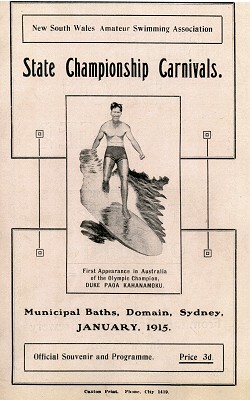 |
Official
Souvenir and Programme: Municipal
Baths, Domain, Sydney, January
1915.
VIEW OF THE HUGE CROWD THAT WITNESSED THE
SWIMMING CHAMPIONSHIP AT THE
DOMAIN BATHS YESTERDAY.
THE COMPETITORS IN THE 100 YARDS SWIMMING
CHAMPIONSHIP
AT
THE DOMAIN BATHS YESTERDAY.
Reading from the left:
W.
Longworth, Duke Kahanamoku, I.
Steedman, B. G. Page, A. W. Barry, G. Cuhna.
|
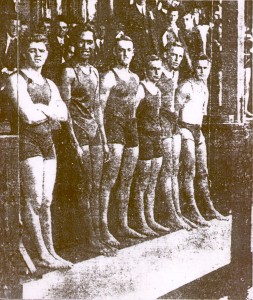
Photographs: The Sun
3
January 1915, page 5.
|
Some of the spectators at the
Domain Carnival may have had a copy of the Saturday Referee
or the Arrow, in which, over a week after Duke’s first
surf riding exhibition, Cecil Healy reported , somewhat
remarkably, the following scene:
"‘What's the boat for,' queried the Duke, in a surprised tone,
when he espied the Manly L.S. Club's surf boat putting into
Freshwater on Thursday last.
'We got them to bring it round to pull your board out for you,'
replied Don Mclntyre, beaming with pride and delight at the
thought that his favorite haunt was to be the scene of the
famous Kahanamoku's first exhibition in Australia."
This is remarkable because Healy was not
actually there, and it demonstrates the speed and enthusiasm
with which “Duke Stories” were generated.
McIntyre was surely aware, if only through W. W. Hill, that
the paddle-out is an integral component of surfboard riding,
let alone distinct possibility that Duke had already
test-ridden the board before the press arrived, even if it
was only early that morning.
If the Manly surfboat was there, and Healy’s is the only
report of this, it is possible that, rather than being
“summoned,” someone at the club was aware of the
demonstration and a quick trip up to Freshwater and back in
the surf-boat was not unknown.
KAHANAMOUKU CARRYING THE
IMMENSE BOARD
ON WHICH HE CARRIES OUT HIS WONDERFUL WATER
FEATS.
It measures
8ft 6in by 2ft. is 3in through at its thickest
part, and weighs over 70lb.
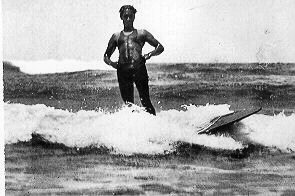
HIS EXHILARATING PASTIME OF SURF BOARDRIDING.
Duke
Kahanamouku, world's champion swimmer, standing
on his surf board shooting the breakers at
Freshwater.
-"Sunday Times," photo.
Photographs: The Globe and Sunday Times War Pictorial,
Sydney, Saturday 2 January 1915, page 3.
|
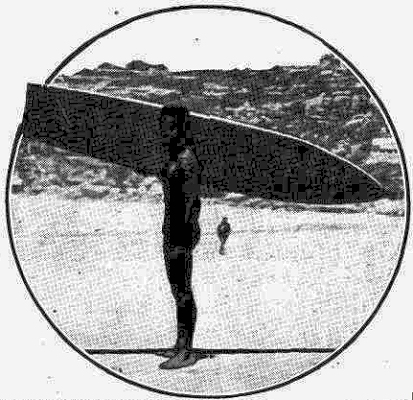 |
The record for the most
outrageous “Duke Story” is his “terrific battle with a
high-powered, man-eating eel" of January 1913, which was quickly
dismissed with considerable ridicule. Healy’s story, however,
regularly appears in accounts of the day, and then often dated
as sometime in January 1915.
Healy also noted that the supplement to the Surf-Bathing
Association's handbook was now available and there had been
contact with clubs from Wollongong, Port Macquarie and the
Maranui Surf Club, in New Zeland.
The Rev. Mr. Purnell, of Gerringong on the south coast, had
requested “a complete life-saving outfit as a first step towards
the formation of a local club.”
Following a recent carnival at North Steyne, plans were being
made to regulate club colours and the wearing of caps as the
“colors worn in several instances were calculated to cause
confusion to officials.” (my emphasis)
Sunday 3rd – 10th January 1915: World’s
Press notes: World’s Record Smashed!
Duke’s time of 53 4/5 seconds reduced the world record for the
straight 100 yards by a full second, previously set by Duke
himself in Honolulu earlier in the year.
In 1915 this was seen as a remarkable achievement, in 2019 it is
inconceivable.
|
FINISH TO THE WORLD'S RECORD BREAKING HUNDRED
YARDS AMATEUR SWIMMING CHAMPIONSHIP
OF
NEW SOUTH WALES AT THE DOMAIN BATHS.
Kahanamoku
leads from G. Cuhna (2), A. Barry (3), W.
Longworth (4), B. G.
Page (5), and K. Steedman (6).
Photograph: THE
REFEREE 6 January 1915, page 16.
By the end of the
week, news of the record was reported by papers across
the country, and then around the globe.
Duke had certainly made his mark in Australia, and the
swimming officials could have only dreamed of such a
performance, even if it saw their local heroes
thrashed.
However, they were competitive with
George Cunha and clearly Duke was an exceptional
athlete.
The fact that the carnival was a
sell-out, with the gate receipts totalling over £600,
erased any previous misgivings about the financial
viability of the tour.
A full-house and a world record also
gave further impetus to complete the negotiations for
an appearance in Melbourne.
|
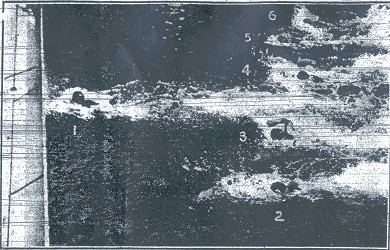 |
For Duke, the pressure was largely “off,” and
there could be no expectation that he could, or should, improve on
his first appearance in the pool.
Tuesay 5th January 1915: Tommy Walker, New
Year’s Day at Yamba.
During the first week of the 1915, the local press covered Yamba
Surf Life Saving Brigade Carnival held on New Year’s Day.
One paper wrote of Tommy’s “interesting exhibition of shooting the
breakers on a redwood surf board 11 ft. long and 3 ft. wide,”
while another reported that “it was fine to see him standing
(sometimes on his head) on the board, sailing in at a fast rate of
speed.”
Aware of events at Freshwater widely acclaimed by the Sydney
press, they commented:
“We can safely say that in Sam (sic) we have a great rival
of ‘Duke’ Kahanamoukua (sic), who is at present creating such a
sensation amoungst the surfing fraternity of Sydney."
Wednesday 6th January 1915: The Second Domain Pool Carnival –
Duke Can Be Beaten (Just)
Australian pride was somewhat restored with the final of the 440
yard championship, hotly contested between Duke and Tommy Adrian,
of Manly.
In the final lap, Adrian was ahead, but Duke stormed back to force
an exciting finish with Adrian winning by the narrowest of
margins.
However, the time was slow, considerably above the world record
set by Frank Beaurepaire, of Victoria, in June, 1910.
There was some disappointment in the crowd that Cunha and Barry
would not compete head-to-head in the final of the 110 yards
Inter-Club Handicap, both being eliminated in the heats. However,
George Cunha did set a new Australian record for the distance.
At 1 minute: 3 3/5, this took two-fifths of a second off the
previous record, set by Duke four days earlier.
During the first Domain Carnival the program was adjusted,
probably due to time constraints, and some of the scheduled high
diving events were dropped.
This prompted a letter of complaint to the Herald,
the writer hoping that the diving would feature prominently at the
next carnival.
His wishes were answered, and the carnival of the 6th had a full
program of diving exhibitions and competition, one reporter
commenting that “there was a good deal of diving- a little too
much in fact.”
Tommy Adrian wasn’t the only winner from Manly on the day.
F. Lough, also representing the Manly Club, was victorious in “the
chase the glow worm.”
While this was clearly a novelty event, the actual rules or method
are unknown.
Thursday 7th January 1915: “Money, Money,
Money”(Apologies to ABBA)
The Evening News gave details of the success of the
first two carnivals, “takings on Wednesday night's carnival
amounted to £160, a total of £750 for the two fixtures.”
The unaccredited journalist went to some lengths to quash any
rumours questioning the amateur status of Duke and Cunha.
Those who “stated that Kahanamoku is to receive a big percentage
of the receipts ... are making a huge blunder.”
He confidently reported that “the visitors do not handle a single
penny (and) Kahanamoku is not even allowed any pocket money.”
When questioned, W. W. Hill, who would have been fully aware of
all the tour’s financial arrangements, noted that the American
authorities had guaranteed Duke's amateur status.
They also requested that the Australian organisations ensure this
was not compromised, and he stated “We said we would do that, and
we intend to keep our word.”
Friday 8th January 1915: Duke
Interviewed.
In an interview with the W. H. Corbett, of Sydney’s Sun,
Duke commented on the antiquity of surfboard riding, and noted
that, contrary to some theories:
“Shooting on a board and in a canoe must have started further back
than body shooting.”
Corbett attributed the introduction of body-surfing
(“surf-shooting”) to “Mr Fred C. Williams (who) picked up the art
from a South Sea Islander and spread knowledge of it amoung the
surfers on the favored beaches of the time.”
The un-named “South Sea Islander” was Tommy Tana, who began
body-surfing at Manly before the turn of the century.
Duke compared the waves and the body-shooting techniques of Sydney
and Waikiki.
He insisted that he was not the Hawaiian champion surf shooter,
“because we had no competitions,” which may not strictly have been
the case.
From the early 1900s, surfboard events were scheduled at the
annual Waikiki Regatta and by 1908 they came to be conducted by
the Outrigger Canoe Club, although, as any contest director knows,
there was always the chance that the swell may not arrive as
required.
Duke was listed as an entrant in the surfboard contest for the
Waikiki Regatta scheduled for New Year’s Day 1907.
The other competitors included Harry Steiner, Curtis Hustace, Dan
Keawemahi, William Dole, Keanu, Dudy Miller, Atherton Gilman, Lane
Webster, and James McCandless; all were noted for their skill on
the surfboard and in the out-rigger canoes.
The swell conditions on the day were of little consequence, the
whole regatta was cancelled with the arrival of “a storm in full
blast.”
The Regatta was re-scheduled to February, and there was sufficient
swell to swamp two of the sailing out-riggers.
The surfboard riding contest was won by Harold Hustace, with
honourable mentions for Harry Steiner and James McCandless.
The surf riding contest in canoes, was won by Dr. A. C. Wall's Hanakeoke.
Most importantly, Duke was secure in his reputation as a surfboard
shaper, as “there were none around Honolulu (who were) able to
shape better than me.”
Finally, Corbett asked about his ear infections and Duke replied
that “three or four times he had to seek medical attention, and
found filling his ears with rubber plugs, which are procurable in
Sydney, or using wadding saturated with oil, every time he swam
till a cure was effected, helped him a great deal.”
To ensure that he heard the starter's signals, he had plugged only
one ear for his record breaking swim at the Domain Pool.
Saturday 9th January 1915: An Easy 220
Yards, with a Sweet Turn, and a Ukulele “Serenade.”
While the weather was not ideal, with consistent showers, the
attendance at the last championship carnival in Sydney was
healthy.
In the 220 yards final Duke cruised to an easy win in conservative
time of 2 minutes 32 2/5 sec, four seconds shy of the late
B. B. Kerian’s record of 1906.
Duke took the lead after the first three stokes and was a full
length ahead before the turn.
This was accomplished with so quickly that many in the crowd
missed it, and on the way home his only potential competitor was
Cunha, who swam off course and opened up the way for Page to come
in second, although still three yards behind the winner.
As Duke commented, “You can't smash records every time you go into
the water.”
Following the carnival, the Hawaiian swimmers were entertained at
dinner at the Fresh Food and Ice Company cafe, King Street,
Sydney, where there were a number of speeches and many toasts were
proposed.
When it came time for Duke to respond, he did so by presenting a
musical number, accompanying himself with the ukulele that had
been provided by Manly’s George Walker.
With Cunha and Evans in harmony, they performed Meliana e,
and, for an encore, By the Sea.
Although the performance earned a wonderful reception, one
reporter found it unusual, “something between the high pitched
notes of a mosquito and the angry hum of a swarm of bees on the
wing.”
Back at Waikiki, the local surfers were engaged with a fight to
preserve their environment , mounting opposition to an application
before the Harbor Commissioners for the construction of an
amusement pier.
While some saw the project as a considerable financial asset, the
surfer’s were concerned that “it will mar the beauty of Waikiki
and interfere with bathing and surfing.”
Sunday 10th January 1915:
Surf-Shooting at Freshwater and Manly.
Unlike the surfboard
exhibition for the Sydney press at Freshwater two weeks
earlier, on this morning there was a sizable crowd,
evidenced by several widely reprinted the photographs of
the day.
One long-shot depicts Duke leaving the water and another
standing with S. Mound, the club captain in front of the
Freshwater clubhouse indicate a crowd of approximately
three hundred.
Duke was also photographed with
his board standing in front of the clubhouse, the crowd
parted around him and with Don McIntyre prominent in the
background.
There are a number of these, with Duke’s right arm in
different positions, and some copies have been roughly
cropped.
There are several shoots of Duke at Boomerang with, not
surprisingly, Don McIntyre along with Fred Williams, Harry
Hay, and others.
These were possibly shot after the morning’s exhibition
and before the surfers travelled south to Manly in the
afternoon.
Strangely, there are no images of Duke riding the board on
the day.
One, which Tim Baker accredits to Don McIntyre, has only
two bathers in the foreground and it is most likely that
this was shot on some other day during a “free-session.”
The most significant photograph is
one of Duke returning to the clubhouse with his board on
his shoulder, surrounded by spectators and enthusiasts.
This shows the surf as relatively clean and the swell
about four feet, breaking about two hundred metres from
the beach and with three lines of white-water.
Most of the crowd are in swimming costumes including four
juvenile enthusiasts carrying small hand boards and one
with a prone board.
Meanwhile, in the shore break a local is attempting to
ride a large board.
Duke Kahanamoku and Board
Freshwater Clubhouse,Sunday
10th January 1915.
Extensively
reproduced, compare and contrast the nose template of
this board with Duke's 1912 Waikiki board, above.
|
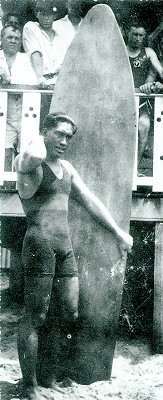 |
According the, not wholly reliable, recollections
of Isabel Letham and Claude West, it could be expected that they
might appear in some of the Freshwater crowd shots.
However, their presence has yet to be detected.
Apparently Duke gave an exhibition of his body-surfing skills
before he used the surfboard, however most journalists gave all
their attention to the later.
The surf was considerably better than in December and Corbett
reported:
"The Hawaiian spent the morning at Freshwater, where he had
a favorable easterly roll, and what he did there in the way of
board and surf shooting surprised every spectator.
He, as he put it himself, 'got it right' several times, and
consequently was, on each occasion, seen at his best."
After the exhibition, Duke gave Fred Williams and H. M. Hay
instruction in the use of the board, going to “considerable
trouble explaining the how and why of his pet pastime.”
Both novices were enthusiastic, telling Corbett that “we've
already ordered a board each.”
It is clear by now that reliable supplies of redwood billets had
been located, but as he was about to leave for Queensland it
probably wasn’t until Duke returned to Sydney at the end of the
month that he would have been able to satisfy the demand for his
boards.
The surf at Manly in the afternoon was not as good as the waves at
Freshwater, but the crowd on the beach was significantly larger,
some suggesting around a thousand.
The crowd in the water was also larger, and Duke had to compete
for the attention of the spectators with “local surfers, who
wished to give exhibitions of their own at the same time.”
A number of photographs of Duke's second appearance at Freshwater
were printed in several retrospective books, notably in Margan and Finney's Pictorial
History and Myers' Freshwater LSC
(1983).
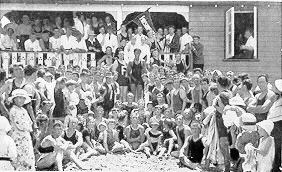
Duke (centre) and crowd
Freshwater
Clubhouse,
Club Captain S.
Mound,
with F insignia,
standing
next to Duke.
|
Duke apres surf, note
his swimsuit drying on rail, left.
Fred
Williams, first local bodysurfer (moustache),
Harry
Hay, Olympic swimmer (to his right).
Don
McIntyre, far left.
'Boomerang'
camp.
|
Duke carrying board in the traditional
solid
wood
manner.
|
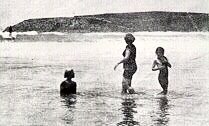
Duke
sliding left.
Don McIntyre,
Olympic
swimmer Harry
Hay and Duke.
Boomerang
Camp.
Longhurst:
Lifesaver
(2000) page 16.
Incorrectly
accredited as Cronulla.
|
 |
On his return from Queensland, Duke would give
two further surfing exhibitions in February, one at Cronulla and
on the following day at Dee Why where he demonstrated tandem
surfing with a young girl from Freshwater, Isabel Letham.
While I intend to further cover the rest tour, it will now be
at a more leisurely pace.
Evening News
Sydney, 5th February 1915, page 2 |
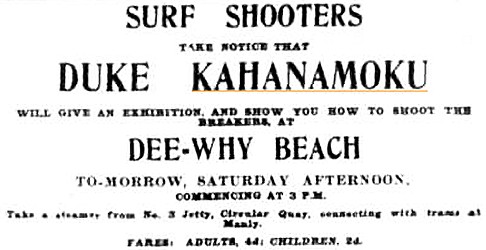 |
Saturday 6th February 1915: Duke and Isabel at Dee Why
Isabel Letham appears only in the newspaper
reports from the Dee-Why exhibition; and not in any of the reports
of those given at Freshwater, or Manly, or the next day at
Cronulla.
However, with Dee Why such a widely anticipated event, it seems
almost inconceivable that they did not have at least one practise
session before appearing in public, and most likely at Freshwater
Beach.
It appears the demand for a
tandem exhibition was ignited by a Sydney reporter writing
that Duke's accomplishments at Waikiki
included riding tandem with a
young boy on his shoulders, and doubting that he would be
able to do something similar in Sydney.
A photograph of this feat appeared in the first edition of
Alexander Hume Ford's Mid-Pacific Magazine in 1911, included with an article Riding the Surfboard,
attributed
to Duke Paoa Kahanamoku.
It was stamped Copyright 1910 A.R. Gurrey Jr.
In one account of the
demonstration, a reporter (the same one?) complained that
the tandem part of the demonstration was hindered by
having a "passenger", and implied Duke would have caught a
lot more waves by himself. |
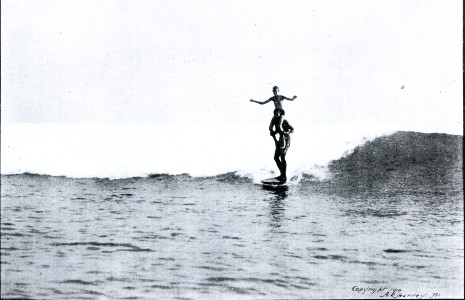 |
Sunday 10th January 2015: Duke's Day at
Freshwater
See: https://youtu.be/AfkDJNQrBZk
Sepia-tinted footage by Craig Baird, ANSM, Torquay:
I had my camera on a tripod
but people just kept jumping in front of it so most was recorded
hand held, and with an old school filter:
Everyone associated with the event deserves congratulations for
their immense amounts of time, effort and enthusiasm that made it
such a success.
Firstly, whoever was responsible for ensuring the excellent
weather and the 4 foot easterly swell deserves everyone’s sincere
thanks.
In particular, the efforts of Eric Middledorp (Don McIntyre) in
the restoration of Duke’s board and the construction of the
replica, Jack McCoy’s presentation of historical surfboards and
the Surf Talk seminars organised by John Ogden, were outstanding.
Apologies to those subjected to my numerous faux pas.
Fred Hemmings- the 53 states of America (and yes Fred, I did get
your resume)
Jack McCoy- for some ill-timed and ill-considered remarks on
the status of replica surfboards.
Jodie Holmes – daughter of Darryl, not Paul.
Terry Fitzgerald-
Special thanks to the person who found my camera and handed it in
to the office.
The Duke Team.
The word legend is often over-used, however as the only surfer to
have a manoeuvre named after him, the Strauch Crouch, the
status of Mr. Paul Strauch Jr. is unique (in the absolute strict
sense of that word).
Mr. Fred Hemming’s water-skills and contribution to surfing is
indisputable.
Mr. Joey Cabell ... sorry, I am simply lost for words.
Simply being in the presence of these three gentlemen was a
humbling experience.
My personal fetish - It was some trepidation that I asked Mr.
Cabell my question:
On the North Shore in the winter of 1967-1968 you rode a Hobie
surfboard with a yellow bottom with a blue foil on the deck.
This has been variously reported as 9ft 3” and 9 ft 5’’ and
as shaped by Dick Brewer?
Joey responded that the board was about 9ft 5” and that he shaped
it.
Digression: I have also note the comment (question?) posted by
Slobadan Madicubich, above.
If The Duke was white I wonder if this would still read like he
was an owned commodity, being used for the benefit of his hosts
capital return/ financial gain & ego.
Slobadan raises the issues of race and commoditisation.
From another medium, the issue of sex has also been canvassed.
In addition there is the matter of death; that is The War.
By 1915 the first Australian troops had embarked for Europe and
while columns were devoted to Duke’s exploits, despatches from the
front consumed whole pages of newsprint.
The honour- rolls of those who would not return would soon appear,
and, before the conflict ended, they would include Duke’s
competitor and enthusiastic supporter, Cecil Healy.
These are complex issues and I am attempting to allocate some time
to think about these.
I may comment more fully in the future.
11th February
1915
Postcard:
To Mr. E.S.
Marks
Aloha Nui
Duke P. Kahanamoku
'Hui Nalu' Swimmer
Honolulu, Hawaii
Sydney N.S.W.
Australia
Feb 11, 1915.
From a private
collection.
|
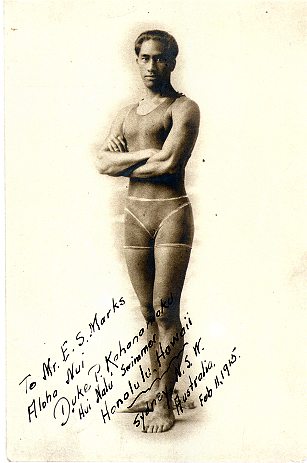 |
Mid-Pacific Magazine
Volume 20 Number February 1921.
Duke
Kahanamoku, the world's champion swimmer, is a
full-blooded Hawaiian.
The
Hawaiians are a vital race and the plan for their
rehabilitation on the land
that was
once theirs, appeals to the strong men of their
race, as it does to
many of their
white brothers.
Hathitrust
http://hdl.handle.net/2027/chi.098054124
|
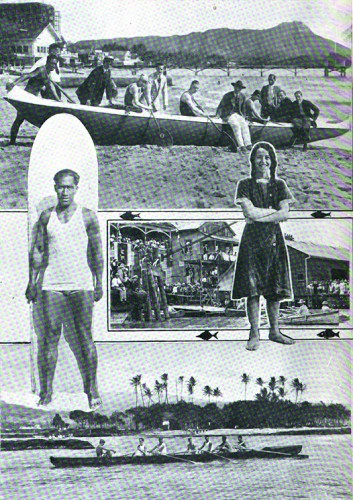
|
Mid-Pacific Magazine
Volume 20 Number March 1921
Duke
Kahanamoku. the world's fastest swimmer‘ makes his
home in
Honolulu and he may
be seen daily in the surf at Waikiki on his
surf board speeding
before the waves that roll in at the Honolulu
beach resort.
Hathitrust
http://hdl.handle.net/2027/chi.098054124
|
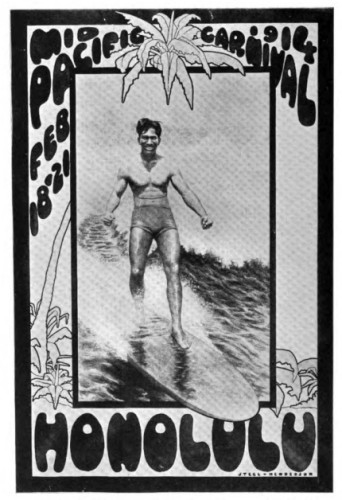
|
Catalogue
Entries:#100
Home:
Haleakala, Honolulu, Oaha
Beach
: Waikiki, Oaha
Competitive
Record
Olympic
medalist swimmer (two gold, one silver), Olympic water
polo representative,Swimming Hall of Fame Inductee,
First Inductee Surfing magazine's Hall of Fame 1968,
Surfer magazine's Surfer of the Century 1999.
Surfing
waterman,surfer,
shaper,
canoe paddler, sailor, introduced surfing to Australia,
New Zealand and East Coast USA, multiple surf rescues,
founder of first surf club, Ambassador of Surfing, Duke
Kahanamoku Invitational Surf Contest 1968 - 1975?
See Duke Kahanamoku in Australia
REFERENCES
Books
Autobiography
Kahanamoku,
Duke With Brennan, Joe:
Duke
Kahanamoku’s
World of Surfing
Angus and
Robertson Publishers Sydney , Australia 1968
2nd
Edition A&R Paperbacks, Sydney , Australia
1972
|
 |
Biography
1. Brennan,
Joe : Duke - The
Life Story of Hawai'i's Duke Kahanamoku
Ku
Pa'a Publishing Incorporated Honolulu, Hawaii 1994
2. Hall,
and Ambrose, : Life
With
the Duke
General
Note : Duke
Kahanamoku's
name appears in almost every general surfing book.
Listed are main
references.
1. Blake,
Tom : Hawaiian Surfboard
Paradise of the
Pacific Press, Honolulu, Hawaii 1935
Reprinted as Hawaiian
Surfriders
1935
Mountain and
Sea Publishing, Box 126 Redondo Beach California 90277. 1983.
Pages 51 -58.
2. C.
Bede Maxwell : Surf
-
Australians Against the Sea
Angus and
Robertson Sydney 1949 pages 235 - 237.
3.
Walter Forbes : The History of the Freshwater Surf
Lifesaving Club 1908 - 1958 page 18.
Reprinted
in Myers, K. (Editor): No Lives Lost :
The
History
of the Freshwater Surf life Saving Club 1908 -1983
Printed by A.
Windsor and Son Pty Ltd, 4 James Street, Wateroo. 699 2829.
1983
4. Bloomfield,
John : Know-how
in
the Surf
Angus and
Robertson 89 Castlereagh Street, Sydney 1959. page
61.
5. Reg
S. Harris in Heroes
of
the Surf – Fifty Years’ History of the Manly Life Saving
Club 1961
records the
date as '15th February, 1915', pages Fifty-three to
Fifty-five.
6. Pollard,
Jack (ed.) : The
Australian Surfrider
K.G.Murray
Publishing Co.P/L,142 Clarence Street , Sydney Australia
1964
Introduction by
Duke Kahanamoku page 7, also pages 27 -28 and 55 - 56.
7. Farrelly,
Midget. As told to McGregor, Craig : This
Surfing
Life
Rigby
Limited, James Place, Adelaide 1965 pages 108 - 111.
8.
Hemmings, Fred : Surfing
Grossett and
Dunlap, New York
Zokeisha
Publications Ltd. 5-1-6 Roppongi, Minato-ku, Tokyo,
106. 1977 pages 18 - 20.
9.
Warwick, Wayne A Guide to
Surfriding in New Zealand
Second
Edition Viking Sevenseas Ltd Wellington, New
Zealand 1978
Chapter : The
Early
Days/Introduction of surfriding into New Zealand.
10.Young,
Nat
; Photographs by McCausland, Bill: Nat
Young’s
Book of Surfing
A.H. & A.W.
Reed Pty. Ltd. 53 Myroora Rd, Terry Hills, Sydney.1979 Page 65
11. Wells,
Lana: Sunny
Memories - Australians at the Seaside
Greenhouse
Publications Pty Ltd 385 - 387 Bridge Road, Richmond, Victoria
3126 1982
pages 150 - 152
and 159.
12.
Myers, K. (Editor): The
History
of the Freshwater Surf life Saving Club 1908 -1983
Printed by A.
Windsor and Son Pty Ltd, 4 James Street, Wateroo. 699 2829
1983
Chapter by Alf
Henderson, page 56.
13. Young,
Nat with McGregor, Craig : The History 0f Surfing
Palm Beach
Press, 40 Palm Beach Road, Palm Beach NSW 2108
1983. page 43 - 47.
14.
Barry Galton : Gladiators of the Surf:
The
Austalian Surf Life Saving Championships - A History
AH & AW
Read Pty Ltd, 2 Aquatic Drive Frenchs Forest NSW 2086 1984
pages 25 - 26.
15.
Lueras. Leonard : Surfing - The Ultimate Pleasure
Workman
Publishing 1 West 39 Street New York, NY 10018.1984
pages 71 - 101
16.Young,
Nat
: Surfing Fundamentals
Palm Beach
Press, 40 Ocean Road, Palm Beach NSW 2108 1985 Page 97.
Same text as
Nat Young's Book of Surfing, above.
17.
Carroll, Nick (editor): The Next Wave : A Survey of
World Surfing
Collins Angus
& Robertson Publishers Pty Ltd
4 Eden Park, 31
Waterloo Road, North Ryde NSW 2113 1991. pages 22 - 29.
18.
Stell, Marion K. : Pam Burridge
Collins
Angus & Robertson Publishers (Australia) Pty. Limited
A
division of Harper Collins Publishers (Australia) Pty. Limited
25 Ryde
Road, Pymble NSW 2073, Australia. 1992 pages 6 - 8
19.
Finney, Ben and Houston, James D. : Surfing – A History of
the Ancient Hawaiian Sport
Pomegranate
Books P.O. Box 6099 Rohnert Park, CA 94927 1996 pages 65 - .81
20.
Warshaw, Matt : Surfriders – In Search of the
Perfect Wave
Tehabi Books,
Inc. Collins Publishers, 10 East 53rd Street, New York,
NY 10022.1997 page 19.
21.
Kampion, Drew. Forward by Bruce Brown : Stoked : A History
of Surf Culture
General
Publishing Group Los Angles 1997
Second edition
Benedikt Tashen Verlag GmbH, Hohenzollernring 53,D-50672
Koin.1998.pages 37- 43.
22.Thoms,
Albie:
Surfmovies
The Blue
Group PO Box 321 Noosa Heads Queensland 4567 2000
pages 20 - 23,
31, 43, 45,64 - 65, 69, 88, and 94.
Web Pages
Legendary Surfers.
Duke Kahanamoku - The Dawn of
Australian Surfing History - 1915 : by Peter Brown.
Article and photographs of Duke Kahanamoku at Boomerang Camp,
Freshwater, Summer 1915 and his introduction of surfing.Also
incudes article on Freshwater SLSC and a comphrensive links
page.Australia.
International Surfing Museum in
Huntington Beach -Oceanside, California. Well presented
with historical data, a few interesting features but the
page is not regulary updated, eg Current Exhibit has been current
for the last 18 months. Also see Surf Culture Orange County site,
above?
Duke Kahanamoku
: surfboards by Kahanamoku Sons:commercial site with some historical
information.Hawaii?
Magazines
Sandra Hall : The
Million
Dollar Surfboard in Longboard magazine April/May
1996 pages
Surfing
magazine 1968
Surfer
magazine 1999
Film (Appearances)
From Thoms
:Surf Movies, 22.above.
Image , top :
"What is it,
Duke?"
Answer : "The
stuff that dreams are made of."
Reference :
Humphrey Bogart in The Maltese Falcon,
paraphasing William Shakespeare.
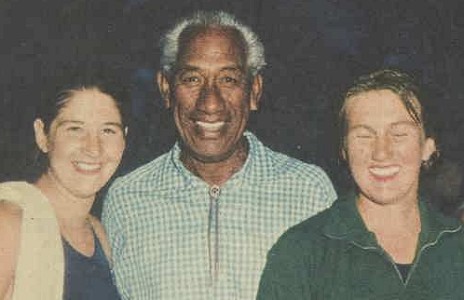 |
Duke Kahanamoku and Australian
Olymic swimmers, Dawn Fraser and Lorraine Crapp, Honolulu 1957.
Trove
1957
'AUSSIE STARS SHINE IN HONOLULU.', The Australian
Women's Weekly (1933 - 1982), 7 August, p. 8,
viewed 27 August, 2013,
http://nla.gov.au/nla.news-article51189967
|
|
Johnny Weissmuller, Duke Kahanamoku and Buster
Crabbe,
Fort
Lauderdale, Florida, 1965.
|
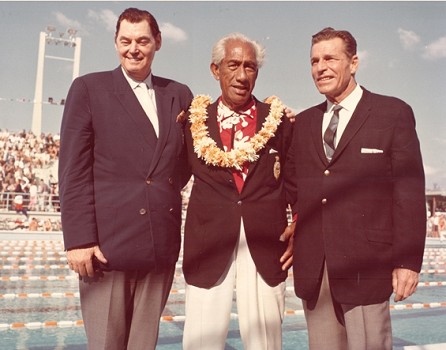 |
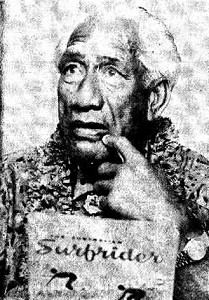
|
Duke
Paoa Kahanamoku arrives in Sydney
yesterday to launch The Australian Surfrider.
The Canberra Times
22 November 1963, page 40.
Duke Paoa
Kahanamoku at Surfers
Paradise.
The
Canberra Times
6 December 1963,
page 28.
|
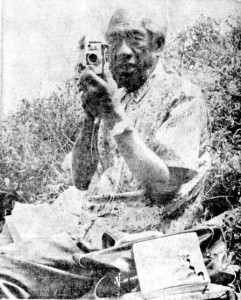
|
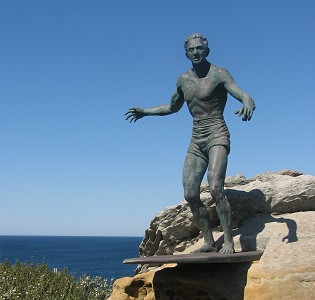
|
Duke Kahanamoku Statue,
Freshwater
Beach
Headland.
Freshwater SLSC.
2007.
|
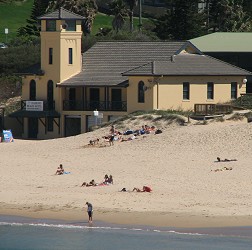 |
Alfred Roy
Horden

"1915
Kahanamoku 10' Redwood Surfboard
Duke
Kahanamoku presented this board as a gift of Aloha to Alfred
Roy Hordern."
- Winnimam, Jim: Vintage
Surfboards 1
- A photo
history of surfboards and surfing collectables.
US
Vintage Surf Auction, November 2008, page 11.
Photograph by
Caprice Nicole Photography.
"Found in
Australia at the Hordern estate, the board pictured here is
perhaps one of the most astonishing surfing relics to ever
surface.
This solid ten
foot wood board was presented by Duke Kahanamoku in 1915 to
Alfred Roy Hordern as a gift of Aloha in appreciation for his
family's hospitality during a visit to Australia."
"Following the
formation of the Palm Beach Surf Life Saving Club in November
1921, letters were sent to a number of prominent weekend and
permanent residents invititing them to be Vice-Presidents of
trhe Club. Amoungst those that accepted the invitation were
... A.I. Hordern."
Brawley: Palm Beach SLSC (1996) pages 12-13.
Note A.I.
Hordern should read A.J. Hordern, see page 26.
Alfred James
Hordern (1859-19 ) was the father of Alfred Roy Hordern
(1892-1935).
"While the
house was being built Alf and Carrie lived in a small
cottage nearby, and it was here that their first son, Alfred
Roy, was born in 1892.
Six years
later they had a second son, Bruce Alexander.
These boys
were to become the enfants terribles of the family in their
time.
Perhaps
Carrie devoted more care to the culture of her plants than
to her children, who were said to be spoilt and wild and
who, together with Lebbeus Hordern, son of Sam, were the
legendary scene-stealers of the fourth generation.
Roy and
Bruce grew up handsome and charming with an exuberance and
recklessness which was the antithesis of their father's
timidity, and, indeed, of the caution of most of their
Hordern cousins.
Roy was
among the first of these young Horderns to go on active
service in World War I; Bruce followed as soon as he was old
enough, and on their return they showed little inclination
to settle to the draper's life, or to any other mundane
existence.
Roy, in
particular, assumed a flamboyant role, and after his death
in Perth as the result of a motor-cycle accident in 1935,
was described by the West Australian press as an
'extraordinary' and 'picturesque' personality-a man of
'magnificent build... deep-chested' and with a 'rugged
he-man sort of handsomeness':
When he
came to Perth ten years ago, he quickly made himself
conspicuous by his mania for speed in a powerful left-hand
steering car which he bought from America, and his huge
Alsatian dogs, which accompanied him into city offices and
hotels... Dress was another of Hordern's odd whims.
Usually he was to be seen wearing an open neck lumber
jacket, riding breeches and Canadian lace-up boots. This,
in fact, was how he was dressed when he died.
..
According to
this obituary, there was one aspect of his life in whicli he
resembled Sam Hordern's family:
Though
he had no special need to work, at odd times he would
become infected with the craze for 'raising' live-stock of
some kind. Once it was pigs. ..another time he went in for
a duck 'ranch' ..."
- Horden, Lesley: Children of One Family.
The Sory of
Anthony and Ann Hordern and their descendants in Australia
1825-1925.
Retford Press,
Sydney, 1985, page 219.
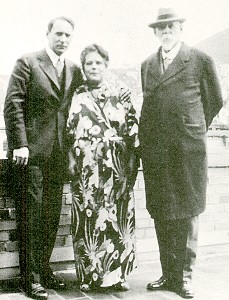 |
Roy Horden with his parents
Caroline
("Carrie", -1938) Doig and Alfred James Hordern,
circa
1925.
Horden,
Lesley: Children of One Family.
The
Sory of Anthony and Ann Hordern
and
their descendants in Australia 1825-1925.
Retford
Press, Sydney, 1985, page 219.
|
"Carrie was a
well-known and popular figure in Sydney until her death in
1938.
A keen
supporter of charities, she frequently opened her gardens to
the public for worthy causes, and 'garden days' were as much a
feature of Highlands (Waitara, Sydney) life as were
'quiet days' at Chiselhurst for the spiritually inclined.
AIf's
enthusiasm for gardening was not as great as Carrie's, and
while the Sydney Morning Herald of 17th August 1932
described him as a 'kindly tree and flower lover', he is
said to have sought refuge from the intensity of
horticulture at The Highlands in his holiday home, Kalua, at
Palm Beach.
This cool,
spacious bungalow overlooking the surf became his favourite
retreat from domestic pressures and the cares of retailing."
- Horden, Lesley: Children of One Family.
The Sory of
Anthony and Ann Hordern and their descendants in Australia
1825-1925.
Retford Press,
Sydney, 1985, page 220.
"New Hordern
faces were also appearing in the two city stores still
operated by members of the family.
Only two of
the third generation - Edward Carr and Alfred - remained in
retailing and they had been joined in Hordern Brothers by the
former's three sons, Edward Dryland ('Ward'), Maurice and
Stewart, and by Alfred's elder son, Roy."
- Horden, Lesley: Children of One Family.
The Sory of
Anthony and Ann Hordern and their descendants in Australia
1825-1925.
Retford Press,
Sydney, 1985, page 313.
"Enlistment in
the services now required a new commitment, since the pre-war
forces had been required to defend home territory only, and it
was the adventure-seekers, spurred on by the prospect of
overseas travel, and anxious not to miss the excitement of a
war which might end before Christmas, who were the first to
join up. Arthur, one of the 'wild' sons of Annie Matthews, and
a grandson of William Hordern I, enlisted in Melbourne on 24th
August 1914, and Cecil Hordern's eldest son, Cecil Anthony, in
Sydney the following day.
The dare-devil
Roy, Alfred's son, having returned from Europe when war was
declared, followed them one month later."
- Horden, Lesley: Children of One Family.
The Sory of
Anthony and Ann Hordern and their descendants in Australia
1825-1925.
Retford Press,
Sydney, 1985, page 334.
"Roy Hordern,
injured in the eye on Gallipolli, returned to Sydney in 1916,"
- Horden, Lesley: Children of One Family.
The Sory of
Anthony and Ann Hordern and their descendants in Australia
1825-1925.
Retford Press,
Sydney, 1985, page 338.
"The return of
Edward Dryland, Stewart, Roy and Bruce to Australia brought
these disagreements to a head. Not only was there competition
for positions of responsibility, but the ill-feeling between
the fathers was matched, if not by unfriendliness, at least by
incompatibility between the sons, and the spirit of rivalry
common in such situations was aggravated by divergences in
attitudes and lifestyles which made it almost impossible for
them to be yoked together.
In this
unhappy state the store struggled on until 1922, when the
partnership between Edward Carr and Alfred was finally
dissolved, and an embittered Alfred retired-together with his
sons-from retailing.
Edward Carr
founded a new falllily firm, Hordern Brothers Limited, with
his three sons, and continued to trade on the same site."
- Horden, Lesley: Children of One Family.
The Sory of
Anthony and Ann Hordern and their descendants in Australia
1825-1925.
Retford Press,
Sydney, 1985, page 342.
"The second
clubhouse on Hordern Reserve in the 1920s showing its
proximity to the Hordern residence (Kalua) which
ajoined it, a little too closely for good neighbourly
relations."
"Upon moving
to the new premises the Club sought further balterations and
contracted a Newport builder to begin work.
As a courtesy
the club informed the Council of its plans to establish a
surfboard locker under the building (to house the reputed 16
boards of members held in the club), and to build a fence.
On both counts
the Council refused, leading to yet more acrimony."
In celebration of Collaroy SLSC's
victory in the Alarm Reel Race at Australian Championships at
Manly 1922, swimmer Ron "Harris' family commissioned Buster
Quinn (a cabinet maker with Anthony Hordens) to make a
surfboard.
Quinn made the board from a single
piece of Californian Redwood at the Dingbats' Camp.
Before it was completed, however,
Harris' father died and the family left Collaroy.
Chic Proctor acquried the board in
Harris' absence and it remains in the clubhouse to this day as
the Club's Life Members Honour Board."

surfresearch.com.au
Geoff Cater (2000-2019) : Surfer : Duke
Kahanamoku.
http://www.surfresearch.com.au/sDuke_Khanamoku.htm


